Tramffordd y Gogarth, Llandudno
TODAY'S ITINERARY
Exploration: Wednesday, 26 June, 2019
lv London Euston 0710 Virgin Trains
ar Chester 0908
lv Chester 0923 Transport for Wales
ar Llandudno 1030
lv Llandudno 1440 Transport for Wales
ar Llandudno Junction 1448
lv Conwy 1643 Transport for Wales
ar Chester 1729
lv Chester 1735 Virgin Trains
ar London Euston 1937
I should say at the start that the Tramffordd y Gogarth is better known as the Great Orme Tramway. In fact Great Orme Tramway is the name on the big sign at the lower station and on the side of the cars. That's for tourists. And what do I think I am? But I enjoy the Welsh language. Tramffordd presents no difficulty if you know that ffordd means road. But then comes trouble. The meaning of Gogarth is no more clear than the meaning of Orme.
Some say [citation needed] that the Welsh garth is a hill or peninsula. There is another rocky peninsula near Holyhead known to climbers as Gogarth. I don't know what go adds to it except a stutter. Meanwhile Orme is said [citation needed] to be from the Old Norse, a word like orm or serpent, from the huge lump of a peninsula, as seen from the sea, resembling a sleeping creature. But the name Orme's Head was not definitely applied to the farthest point until the eighteenth century, and the name Great Orme for the whole mountain seems to have come into use only after Llandudno was created as a holiday resort in the 1840s. So I am not sure we know what either name means really. Let's not worry about it.
I was off once again from Euston. Enough said about Euston.
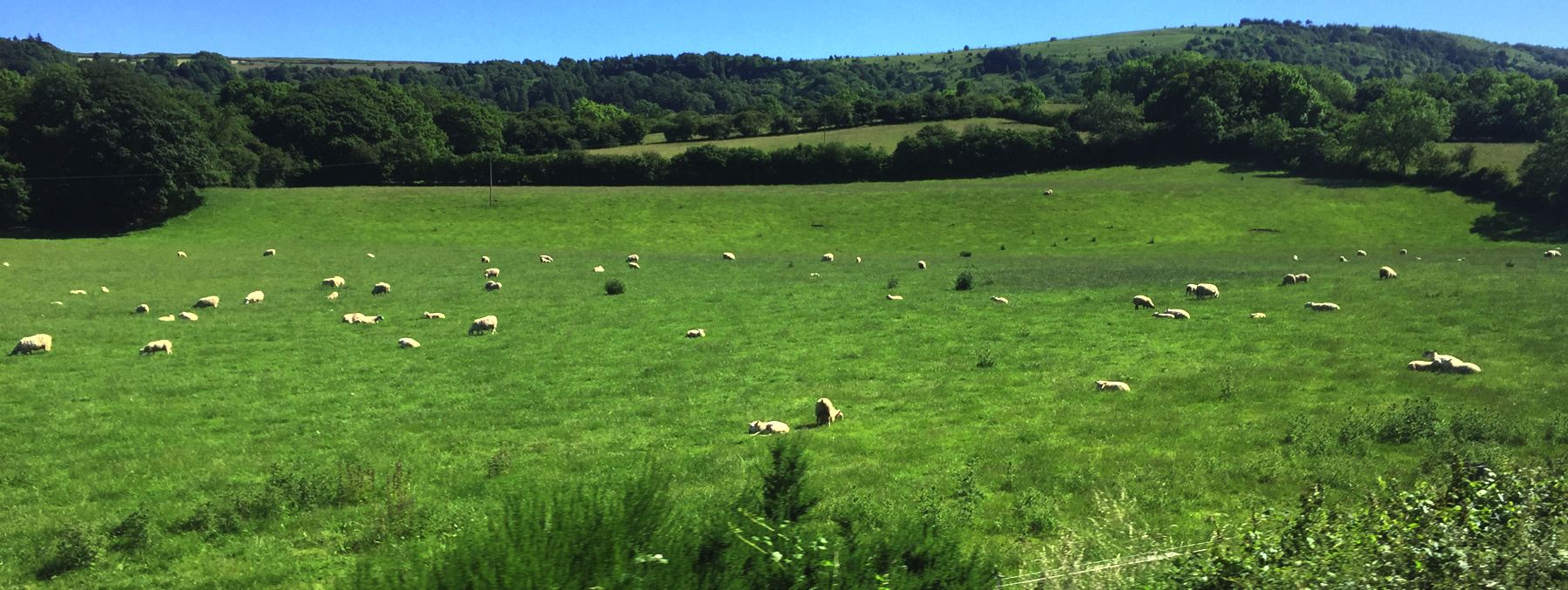
The National Sheep Association puts the sheep population of the United Kingdom at 33 million. I saw many of them.
Chester, an important railway junction, has the appearance of something hit in the second world war and not yet restored, but not so. Despite its strategic location it was not bombed. It was just enlarged repeatedly at different times, and it shows what can happen when there's no master plan, just a series of improvements.
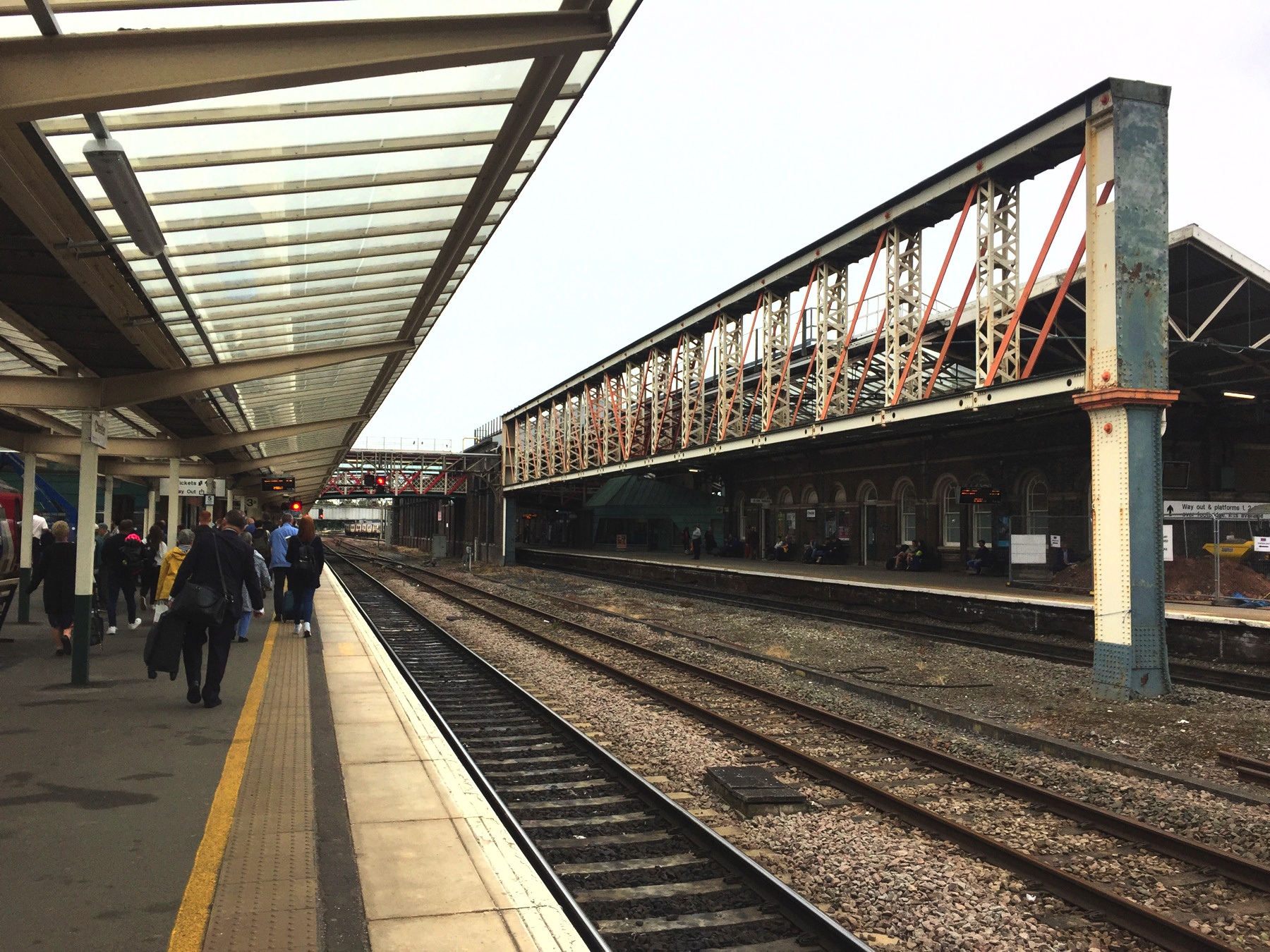
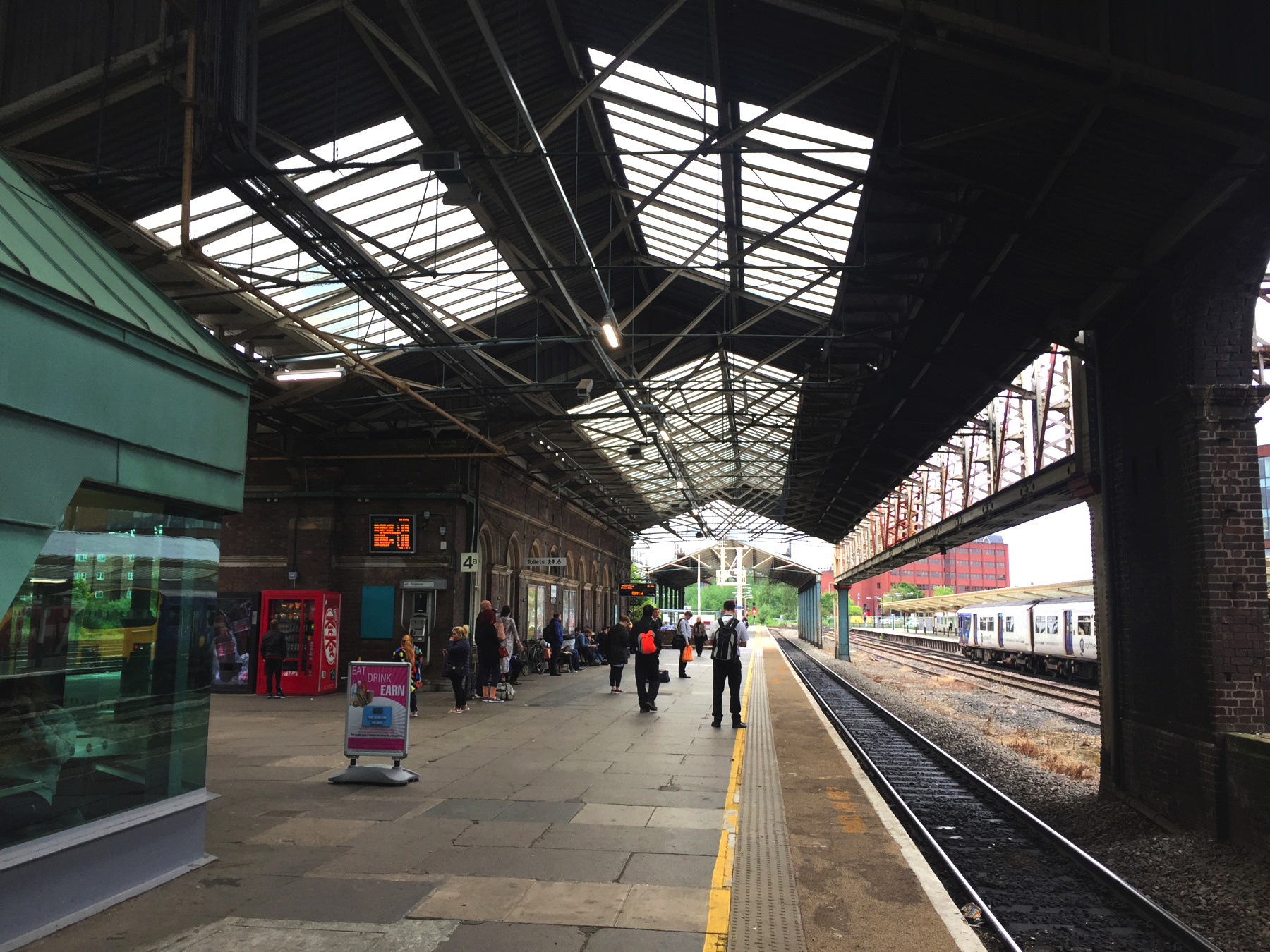
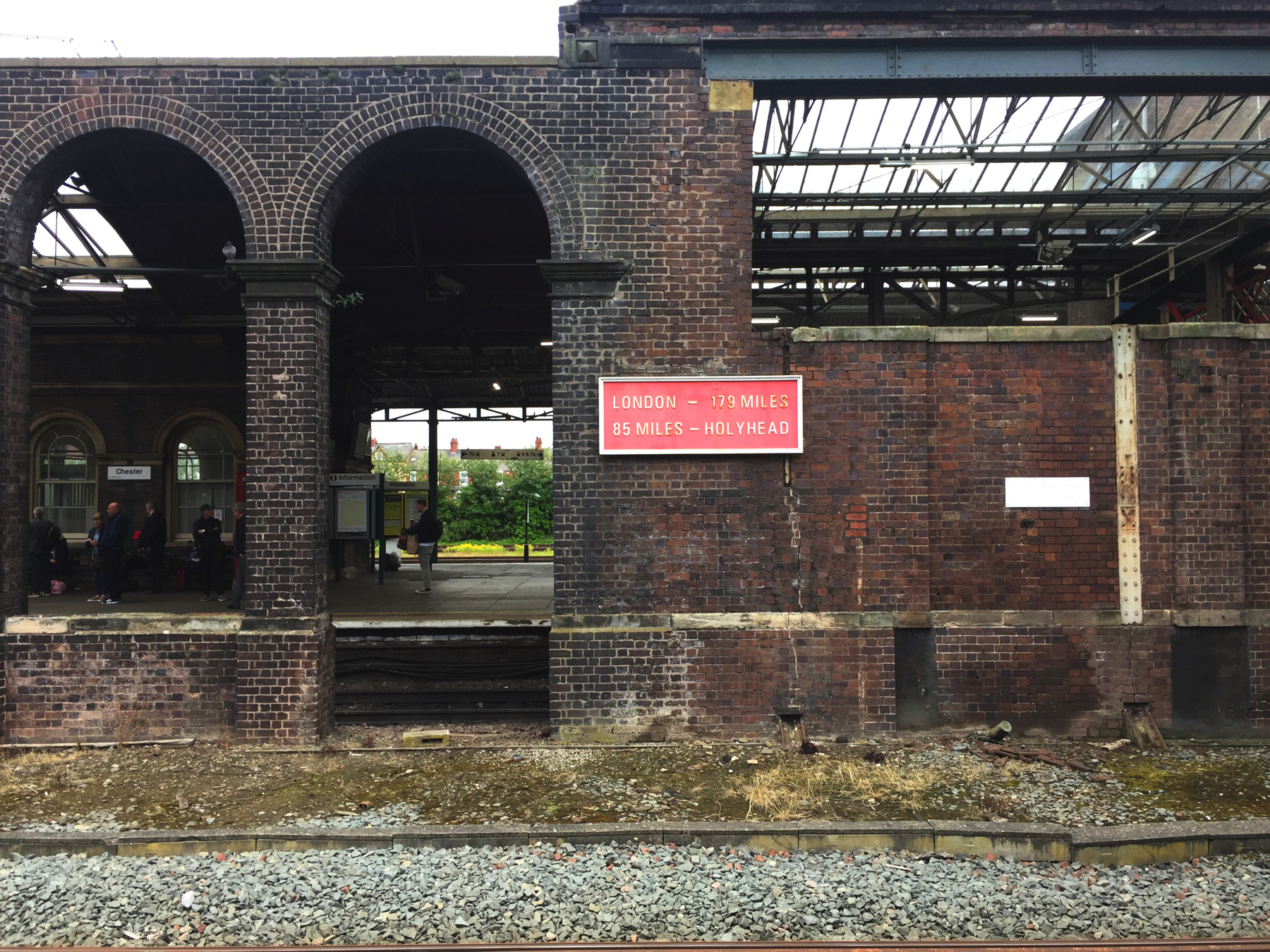
I am not the only fan of the red sign at Chester showing mileage. Yes, we did 179 miles in two hours!
The railway to Llandudno runs for a long way along the north coast of Wales. I grabbed a couple of shots through the train window as we were getting near Llandudno Junction and the Great Orme was coming into view. As you can see it was a grey morning. And the windows were dirty.
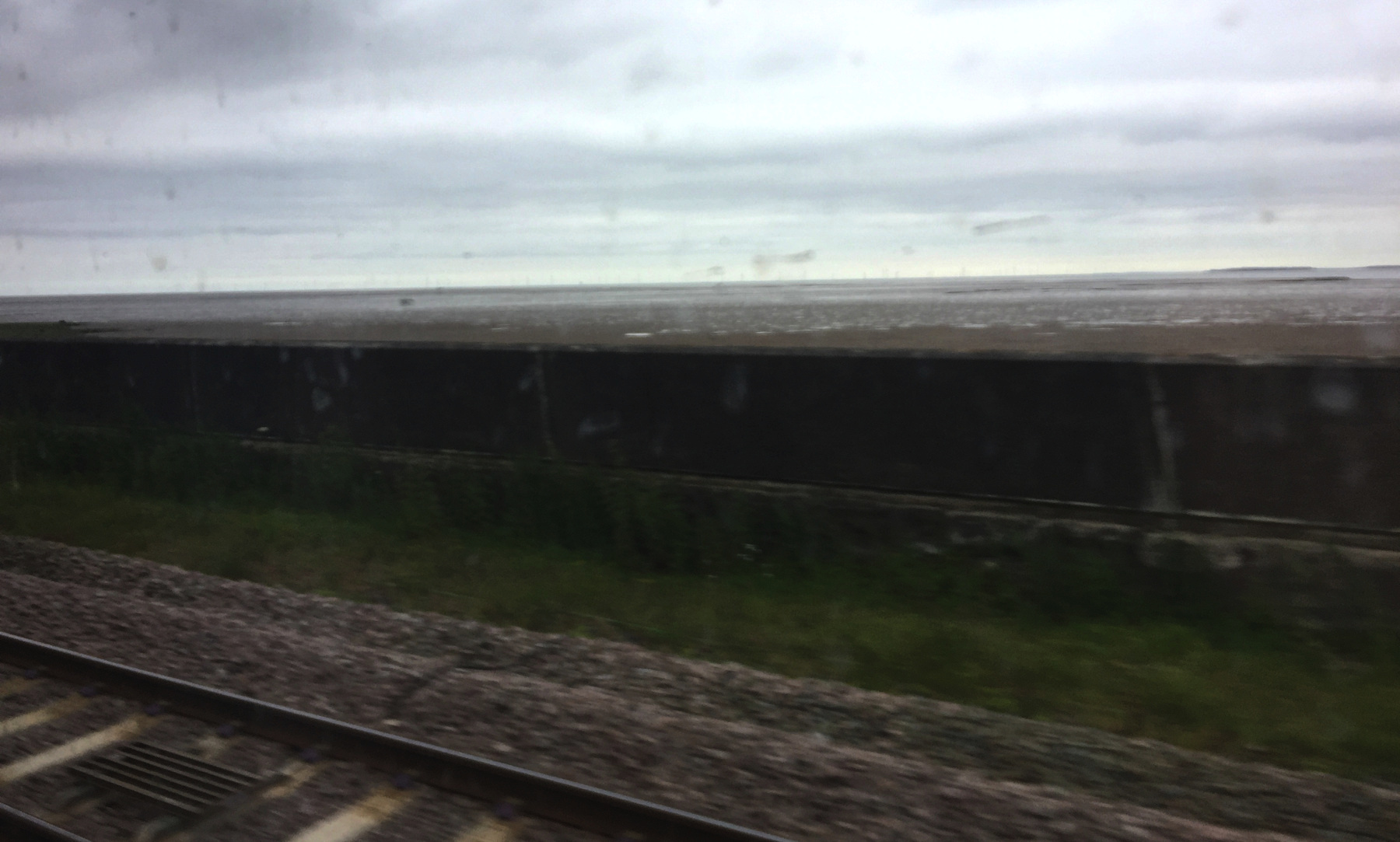
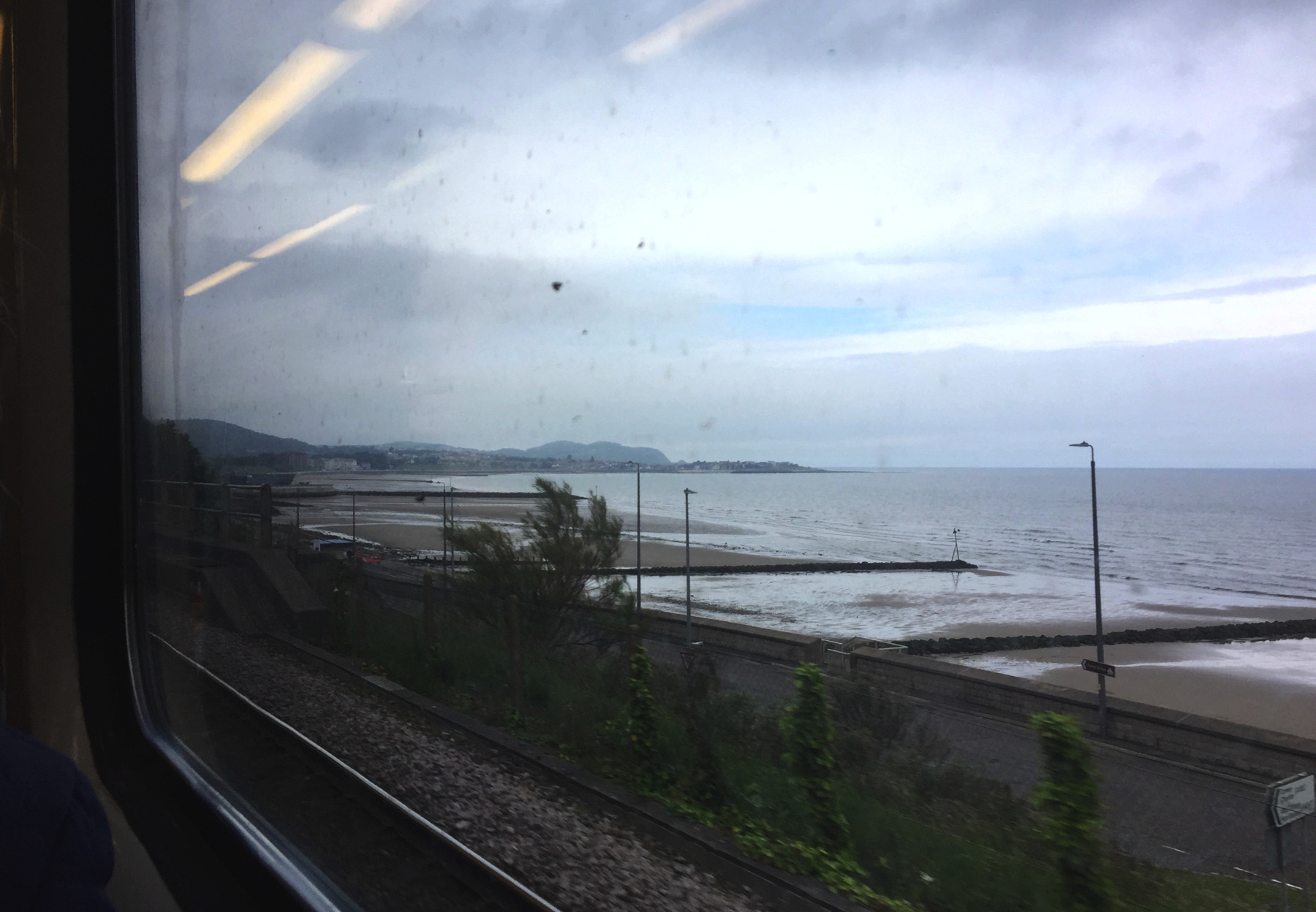
See that lump in the distance? Is it a great sleeping beast?
Trains on this route diverge at the base of the peninsula, at Llandudno Junction, some like ours going up the branch and some continuing west to Holyhead. The terminus at Llandudno was built for more traffic and more tracks than it has now.
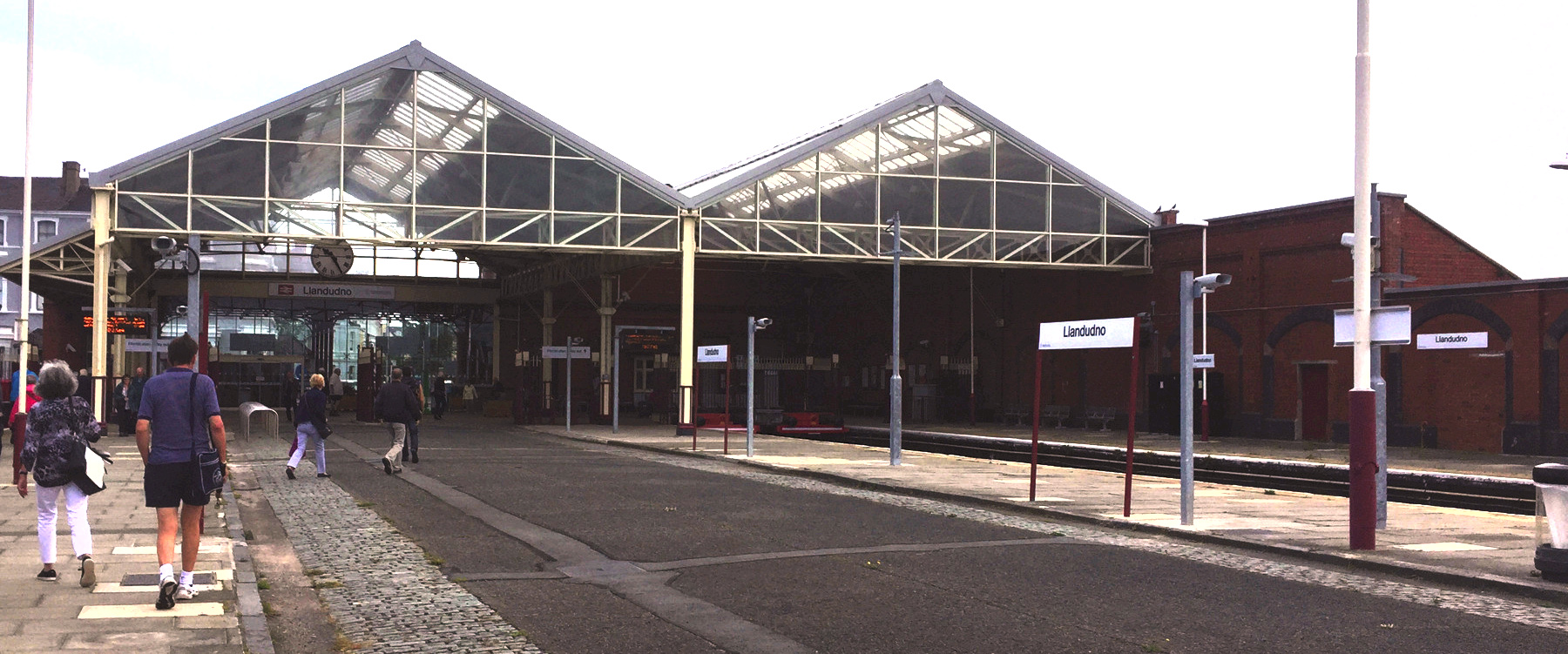
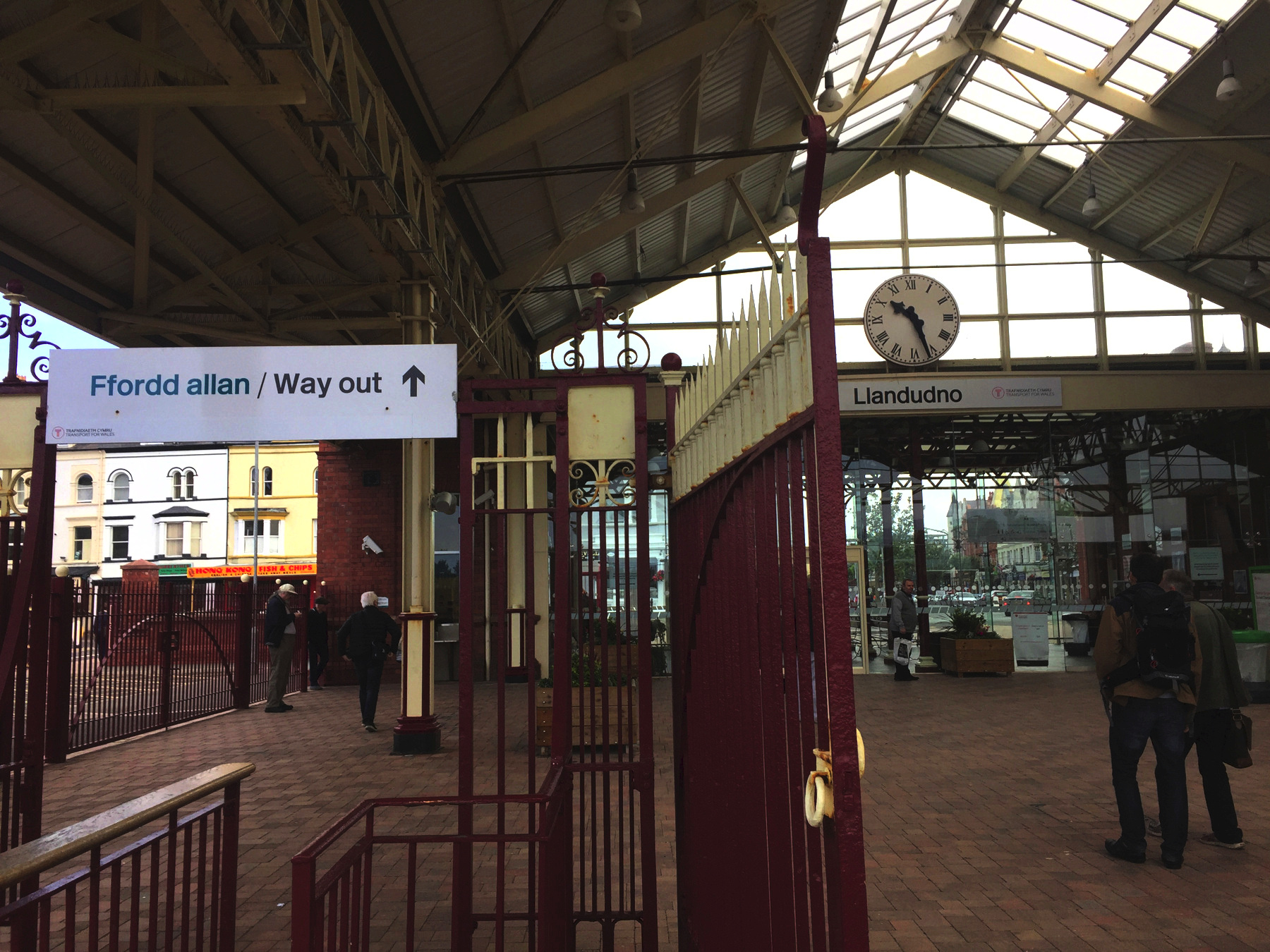
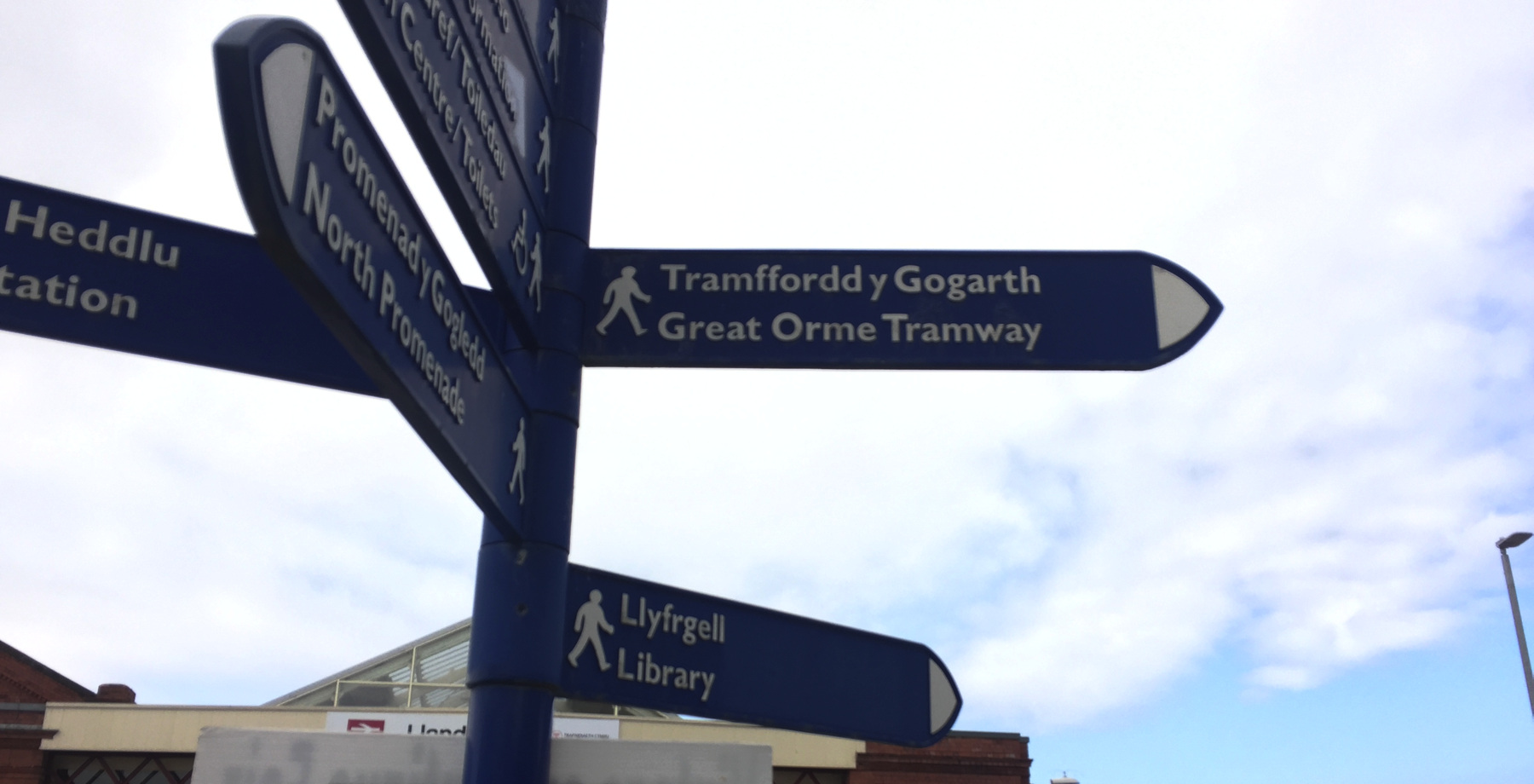
Signs outside the station direct you to local places of interest including Tramffordd y Gogarth, but you can tell when you're walking toward the Orme.
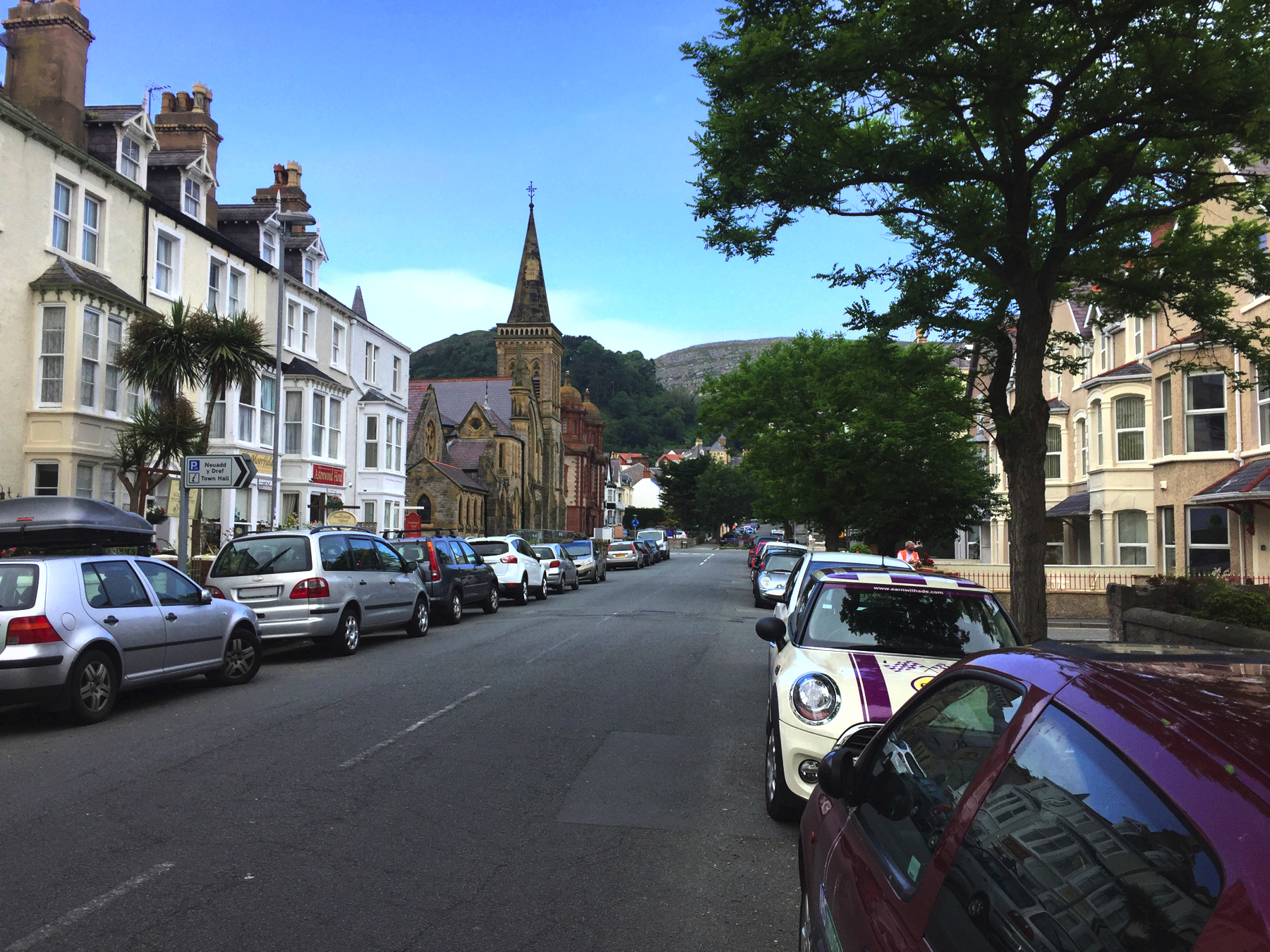
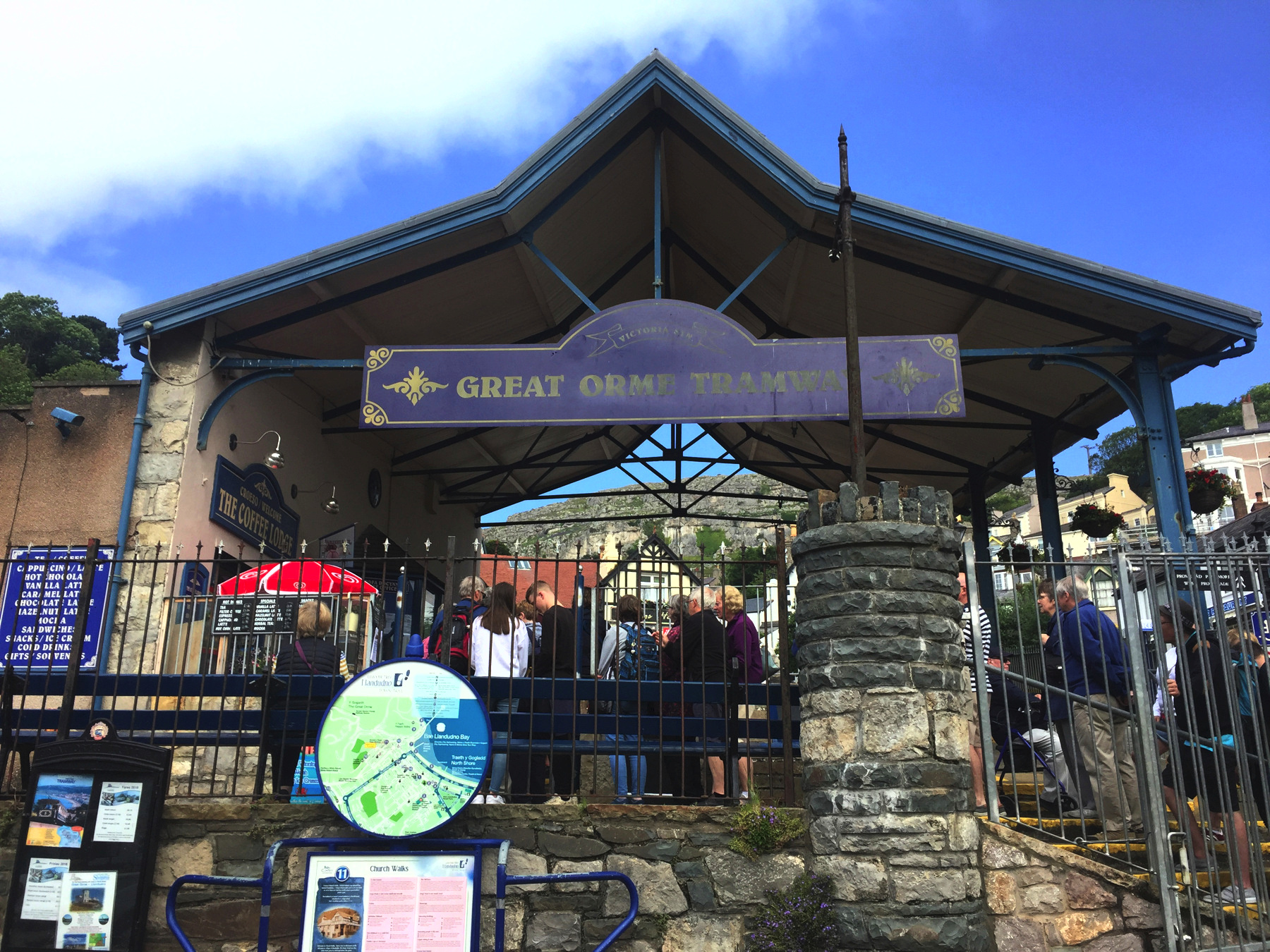
Victoria station was the only place in this whole series where I could not walk up, pay the fare, and board the next car out. What a crowd! And it was not a weekend, and it had not started a sunny day. Tip: if this happens to you, the procedure is to walk past the people and get a ticket at the window, and then go back and join the queue. I was among the first-timers who realized it a little late, but we agreed with each other that we would go get our ticket one by one and be allowed back in where we'd been. No fights broke out. Not even when a school of children in uniform showed up and seemed to be cutting in ahead of all of us.
Tram 5 came in, tram 5 loaded, and tram 5 went out. I had the opportunity to take good pictures of it.
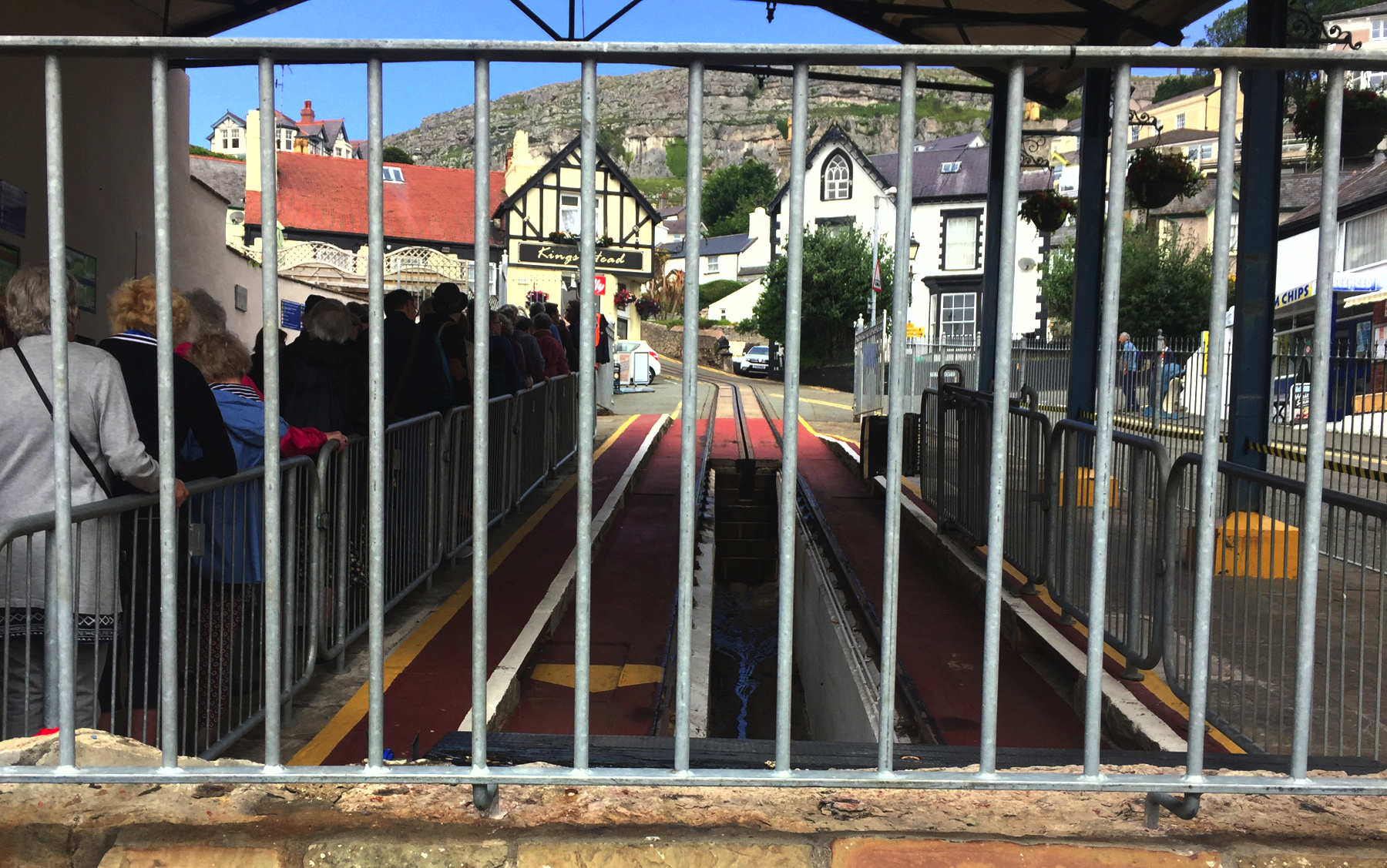
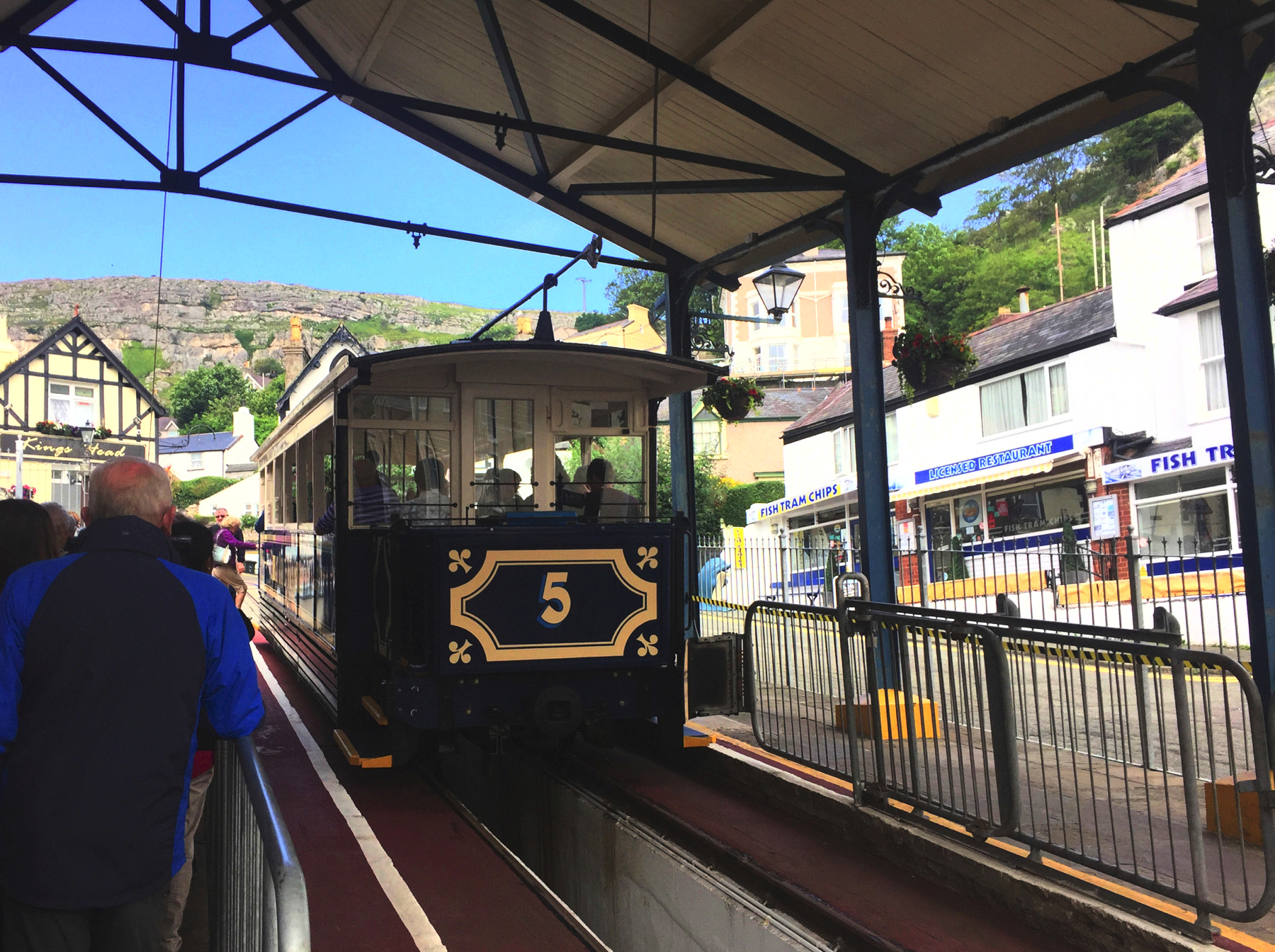
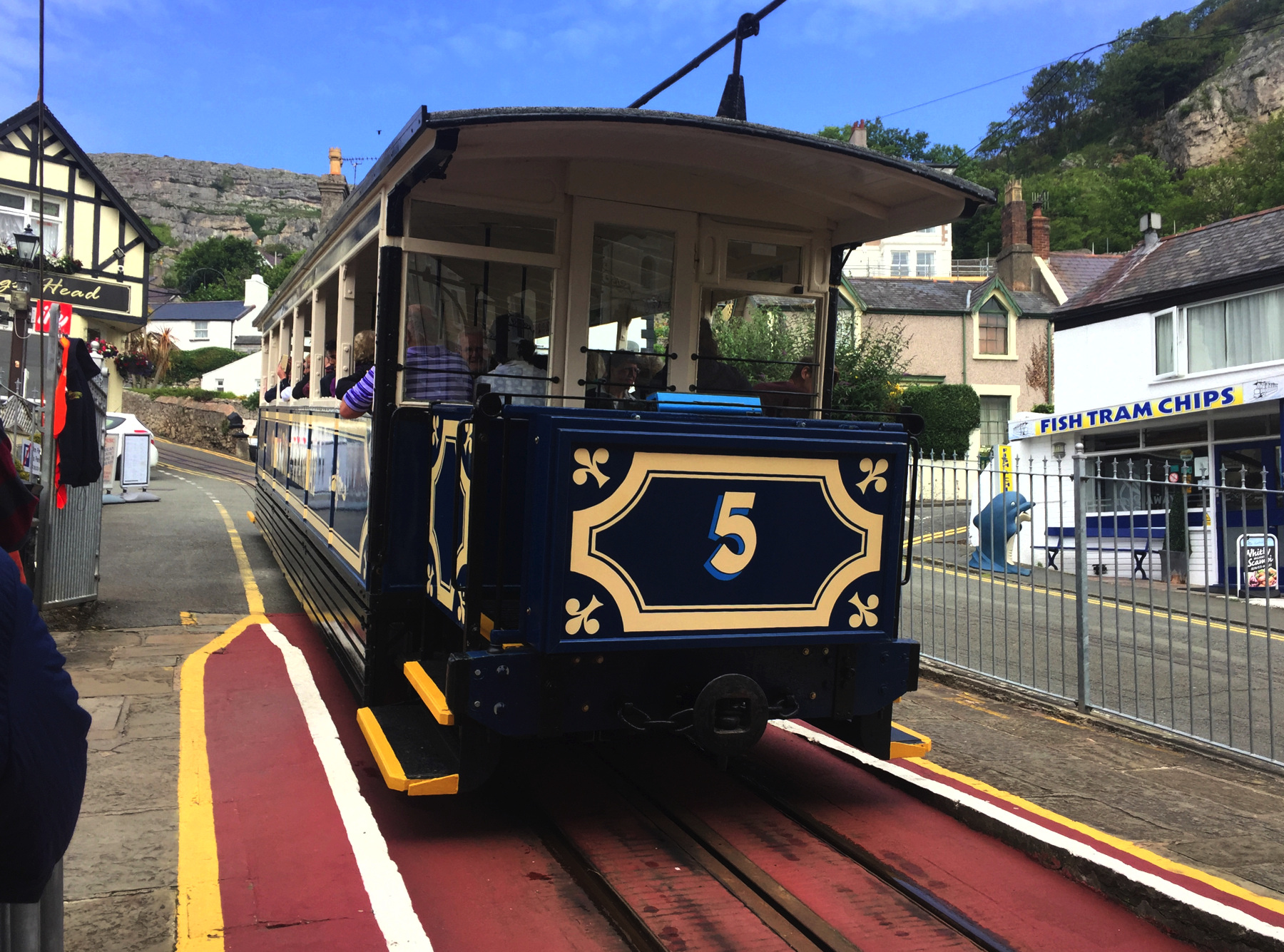
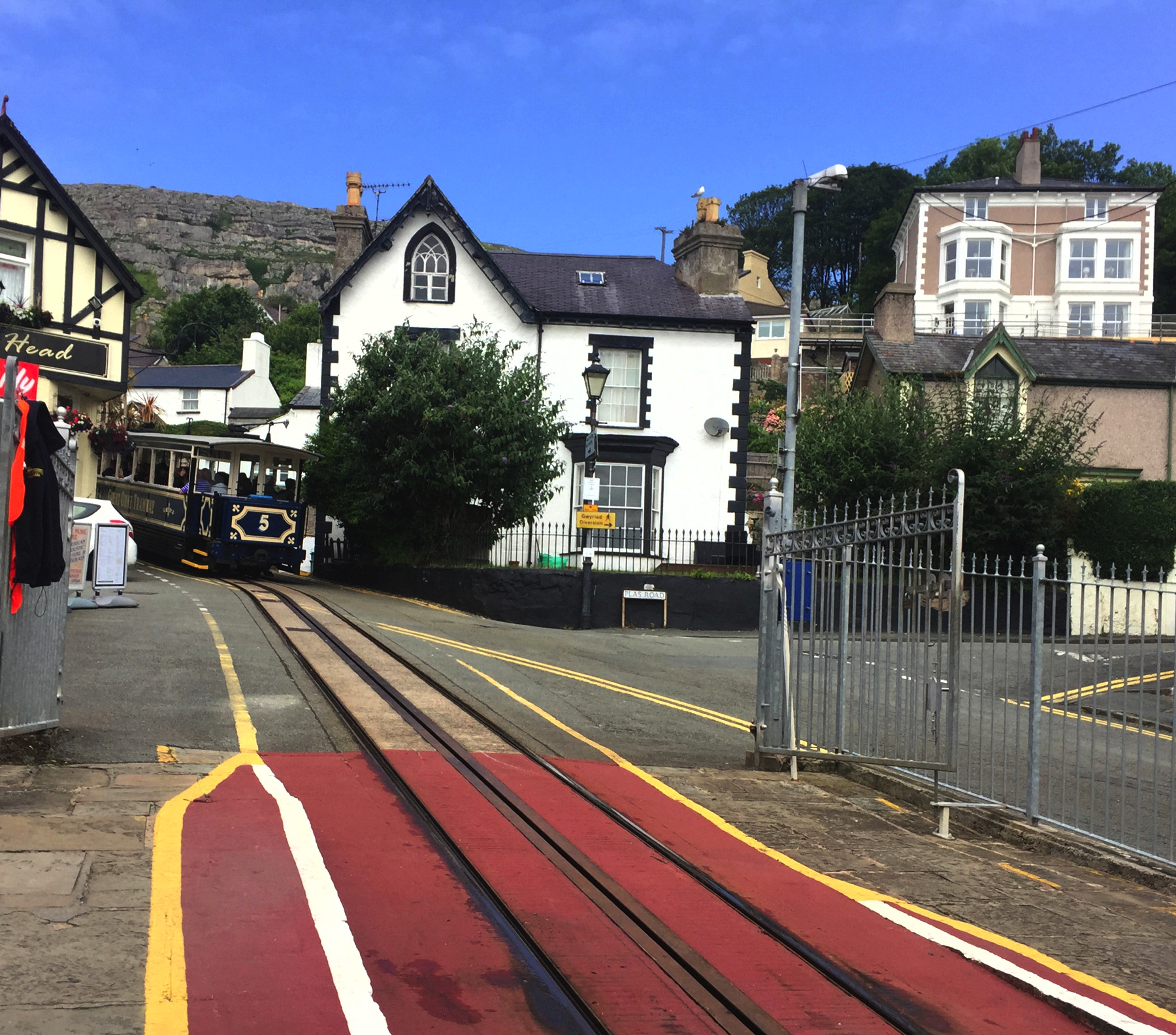
Yes—it starts by going up in a public street for a couple of blocks. While we were waiting for the other tram, I asked one of the staff what would happen if the tram should meet an automobile around the bend, and he assured me they can signal to stop the cable. The "attendant" has no direct control of the car but he has electric controls to signal to the engine house.
The Great Orme Tramway is two funiculars. You change cars at Half Way station. The Lower Section has, in this order, single track in street, single track on the side of the road, a passing place with double track, and gauntlet track on the side of the road, all of it laid in pavement. The Upper Section has only single track except double at the passing place, and none of it is in pavement except at three level crossings. Did you get all that? Here is a map.
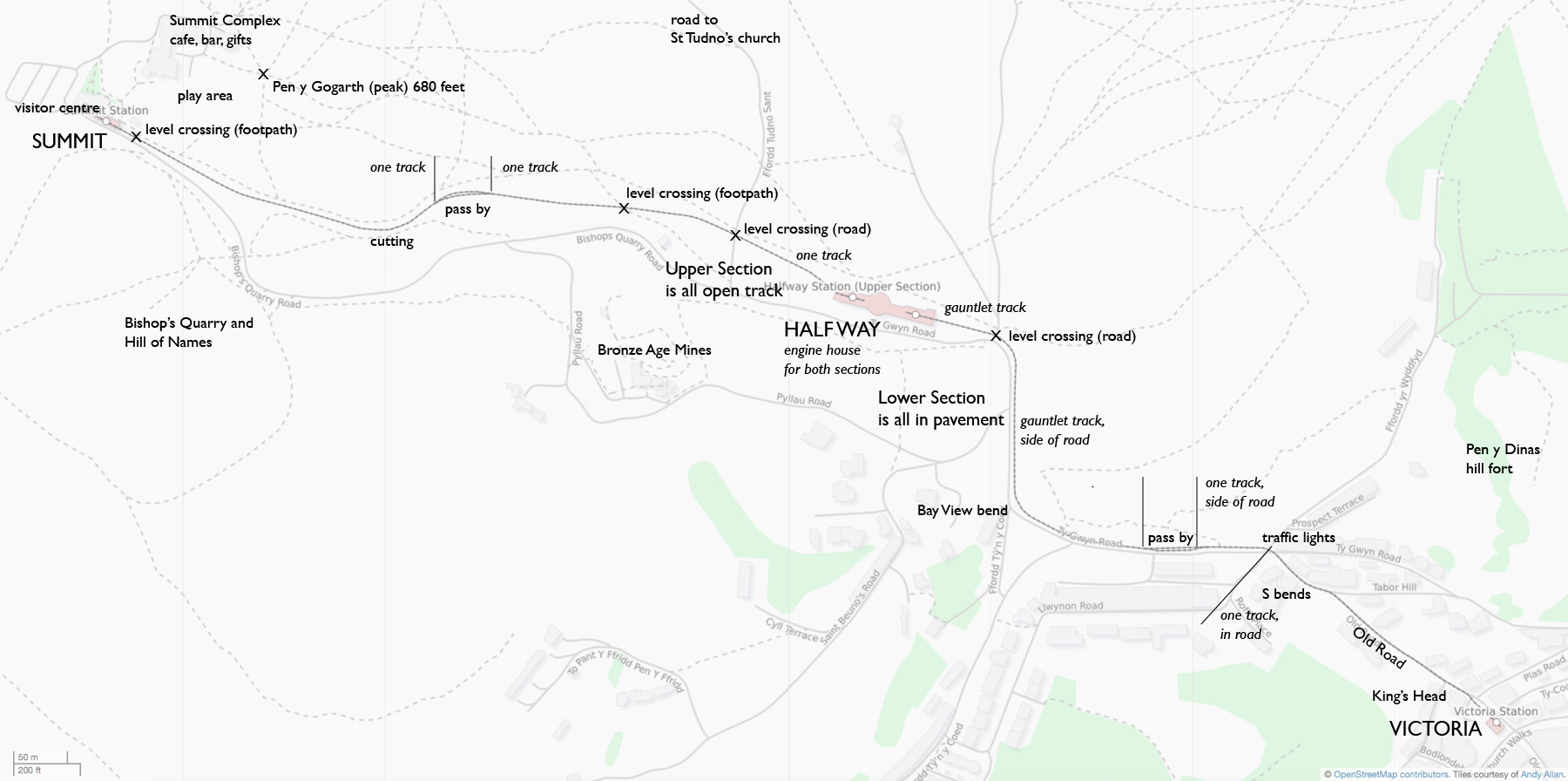
Going up the Lower Section, I was crowded into a seat, from which it was hard to take good pictures, so I decided to take some on the way down. Here are some of those, looking down.
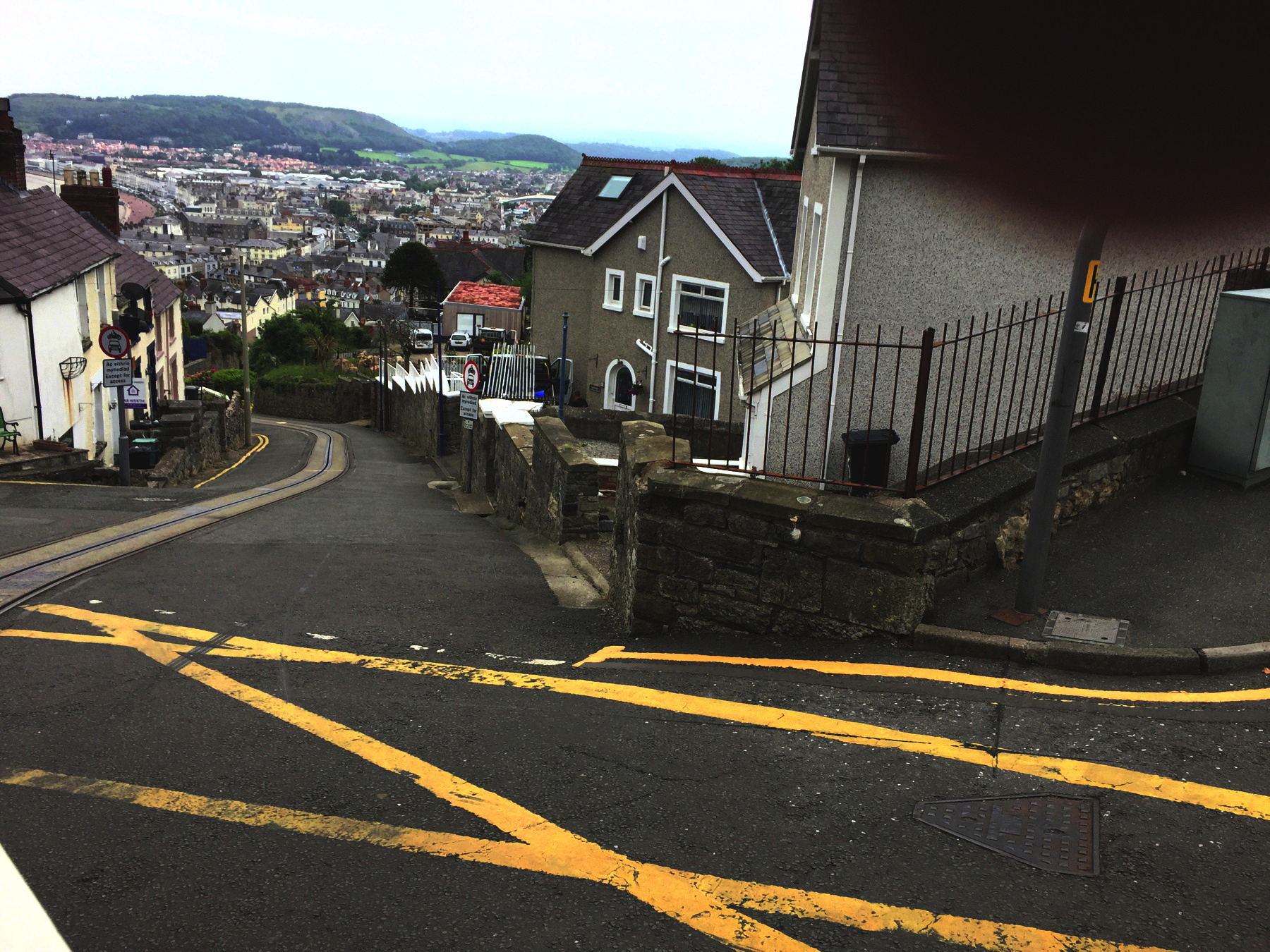
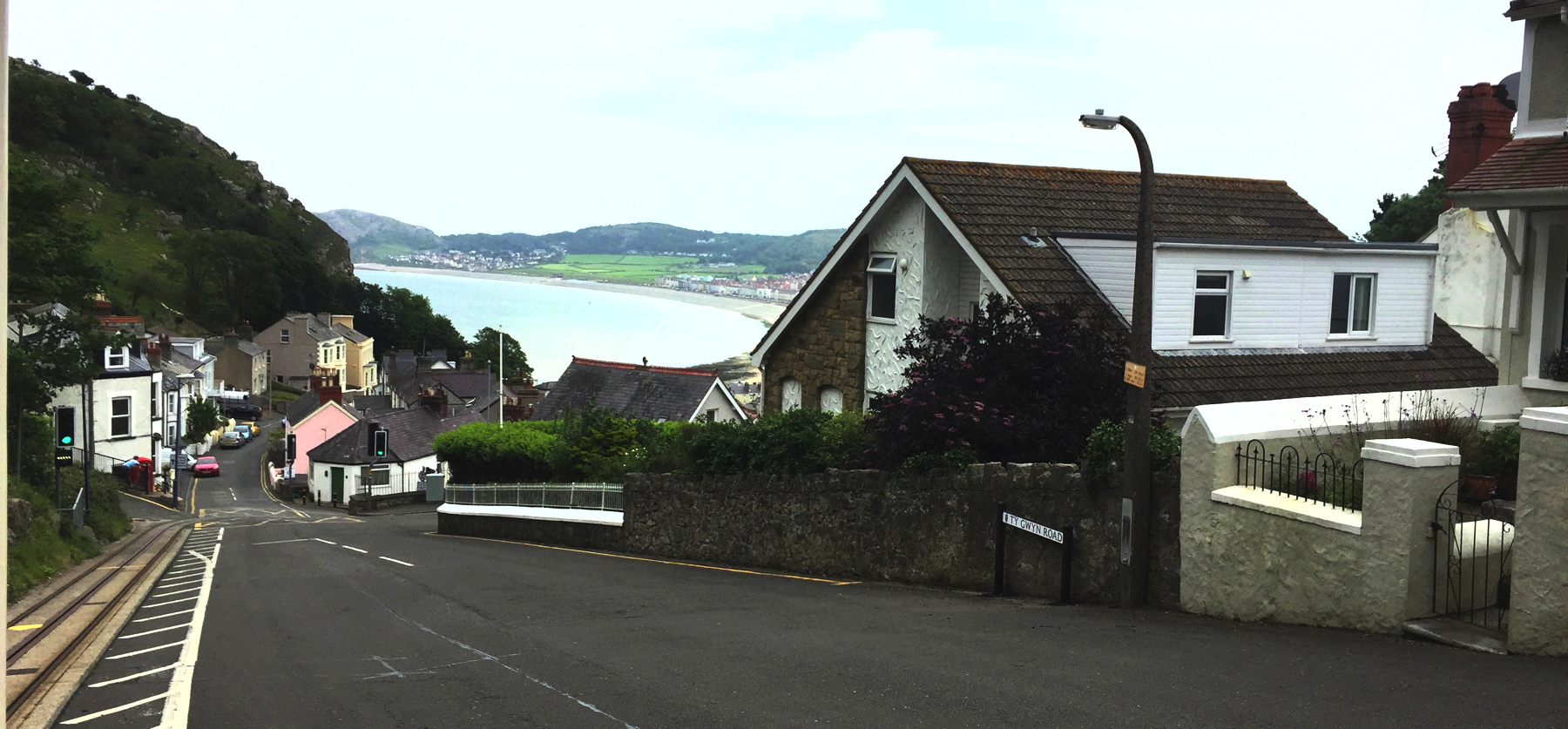
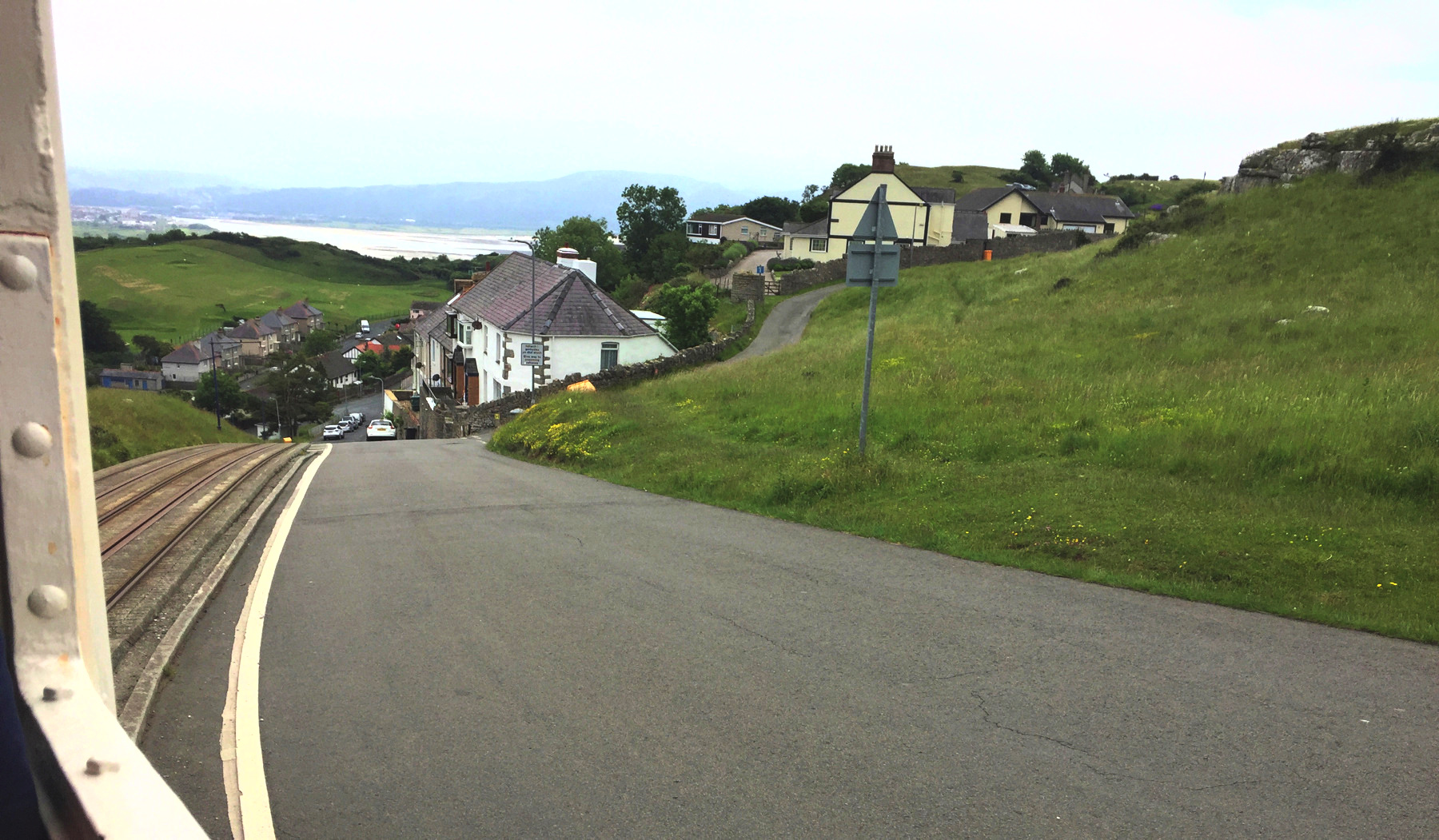
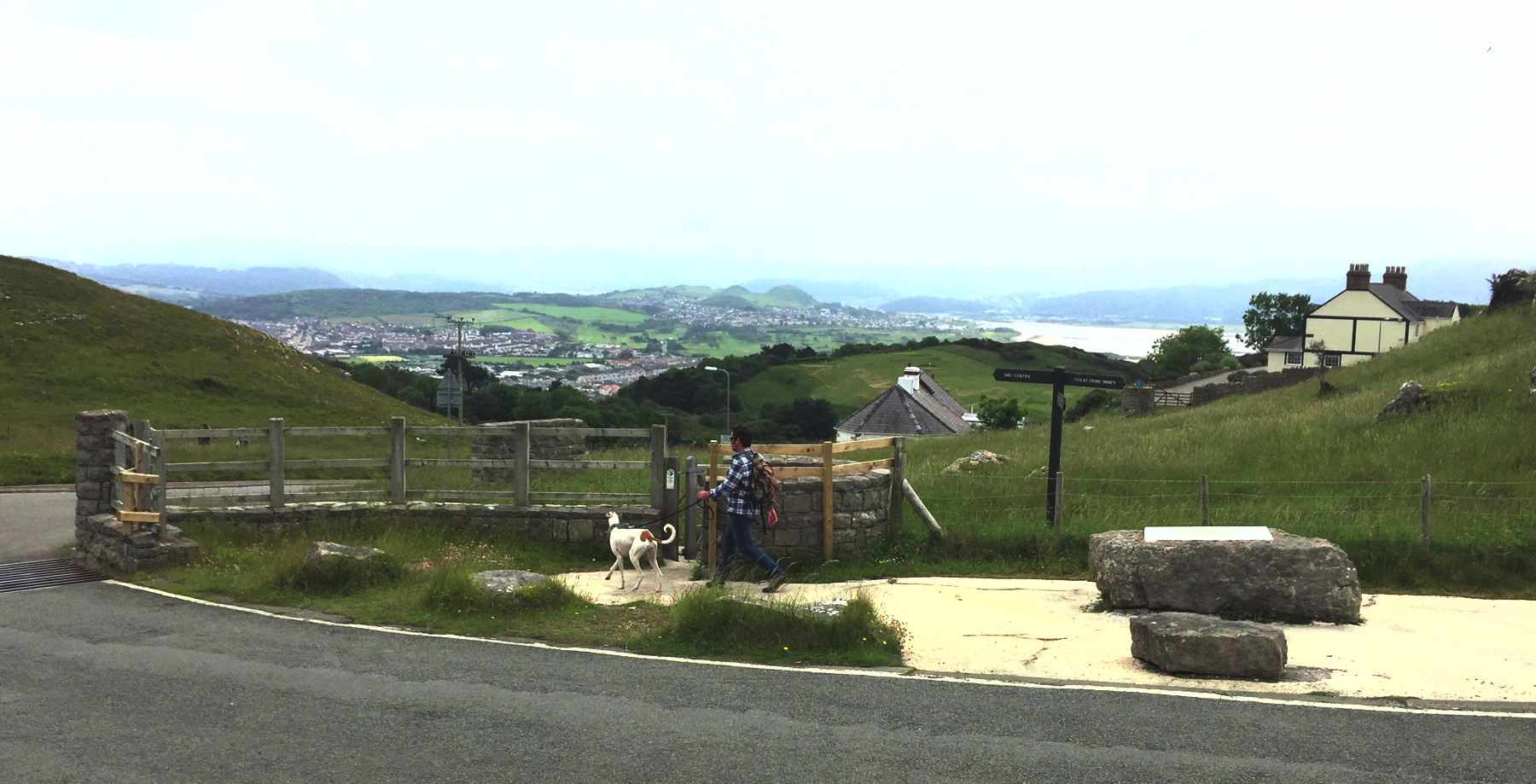
One the way back I also walked around a little near Half Way. Below, here is tram 4 at the level crossing. The Lower Section has cars 4 and 5, and the Upper has 6 and 7. I saw no place to store more cars. Atlas Obscura reports that cars 1, 2, and 3 were freight cars that were retired in 1911.
You may have noticed the mysterious trolley poles on the cars, and you can see here a support pole for trolley wire that is now missing. The wire was not for traction power but for a telegraph signal between the tram car and the engine house. Radio has been used since 1991. It's approaching thirty years since the poles served any purpose!
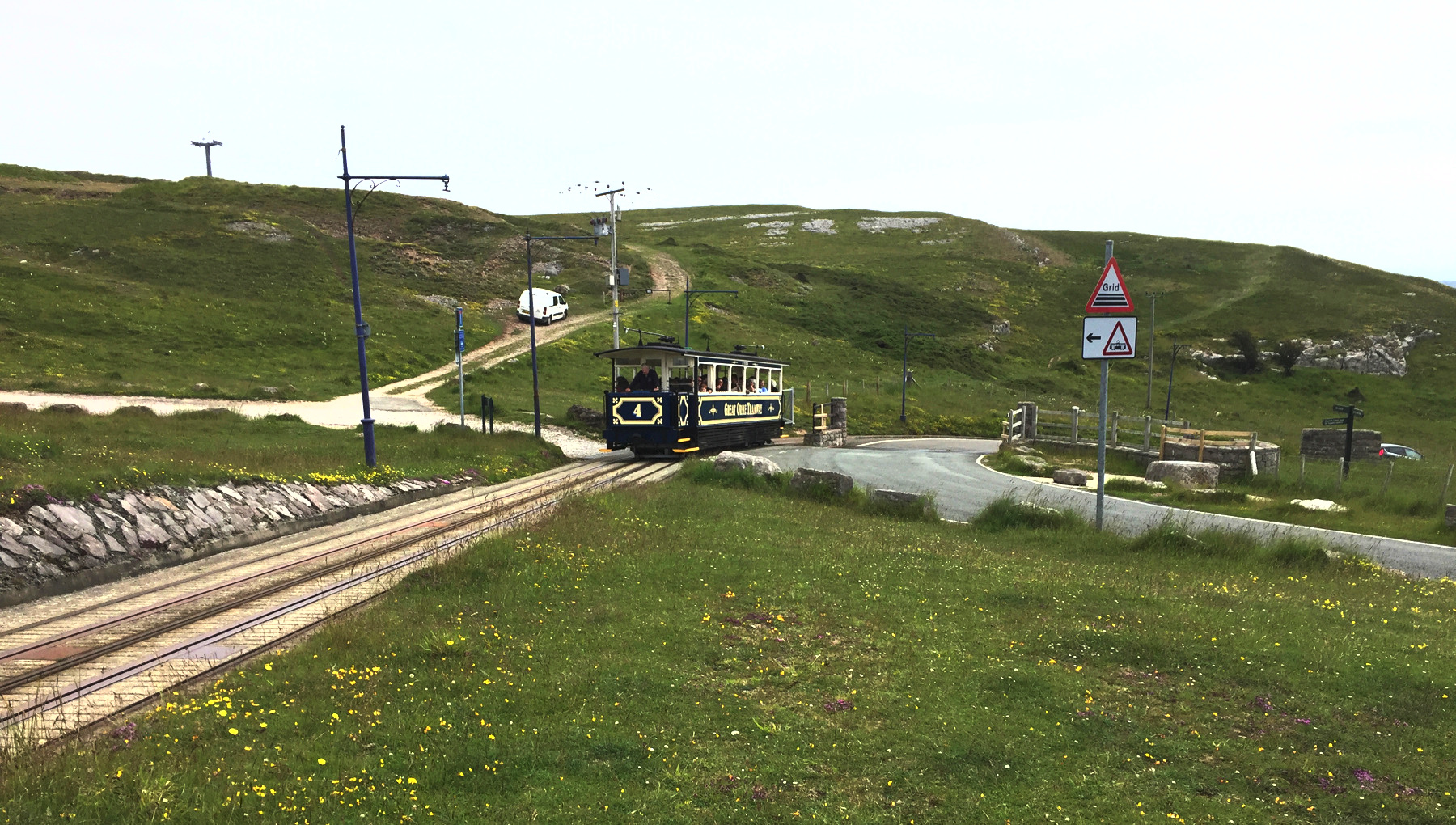
The close-up of the track reveals that what appears at a glance to be three-rail is four-rail gauntlet track—unless it is three rails with a custom-made center rail that has two upper surfaces. The wheels of a tram car on the nearer track rest on the nearest rail and on the farther of the two inner rails. I have never seen this before.
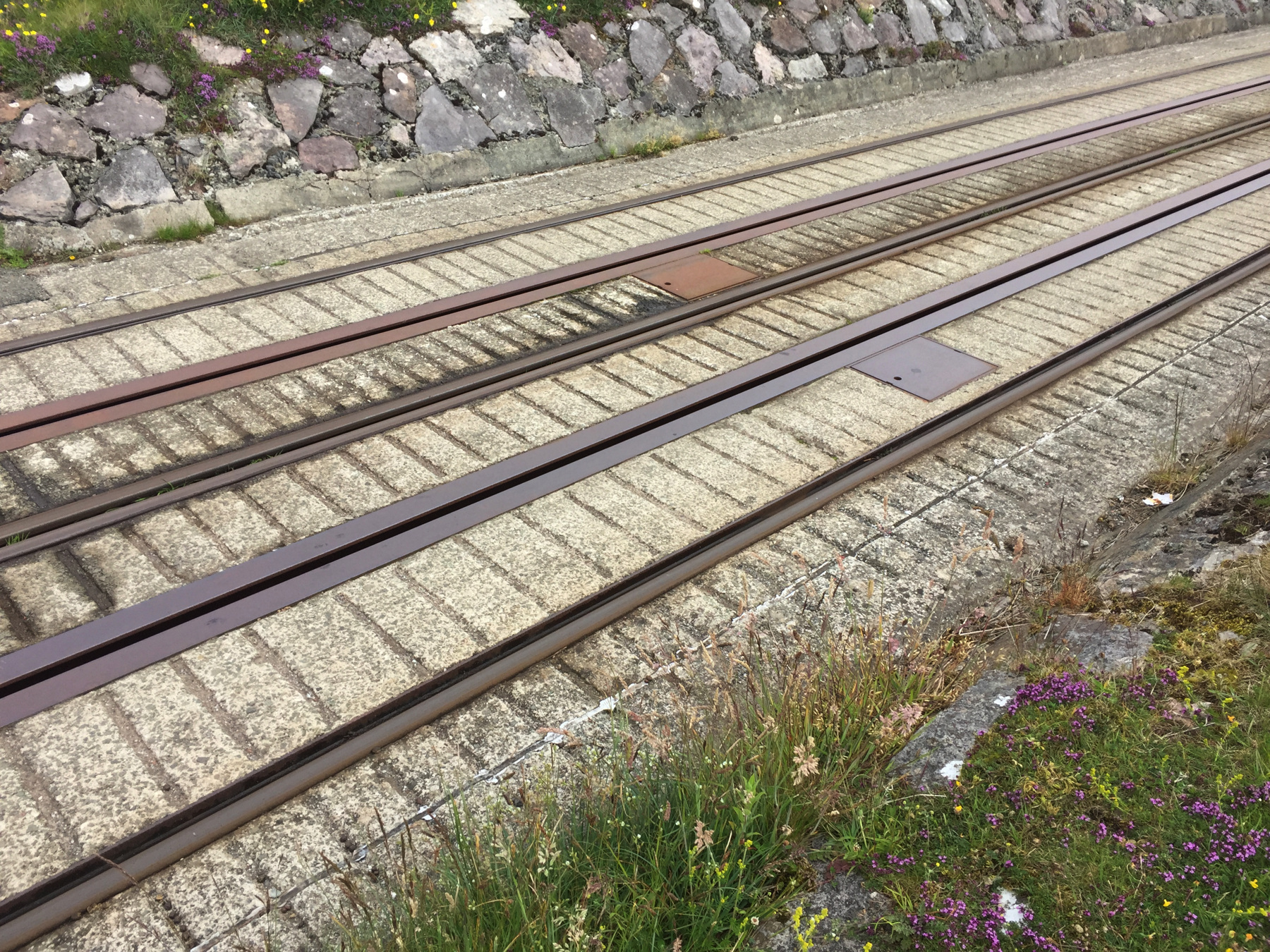
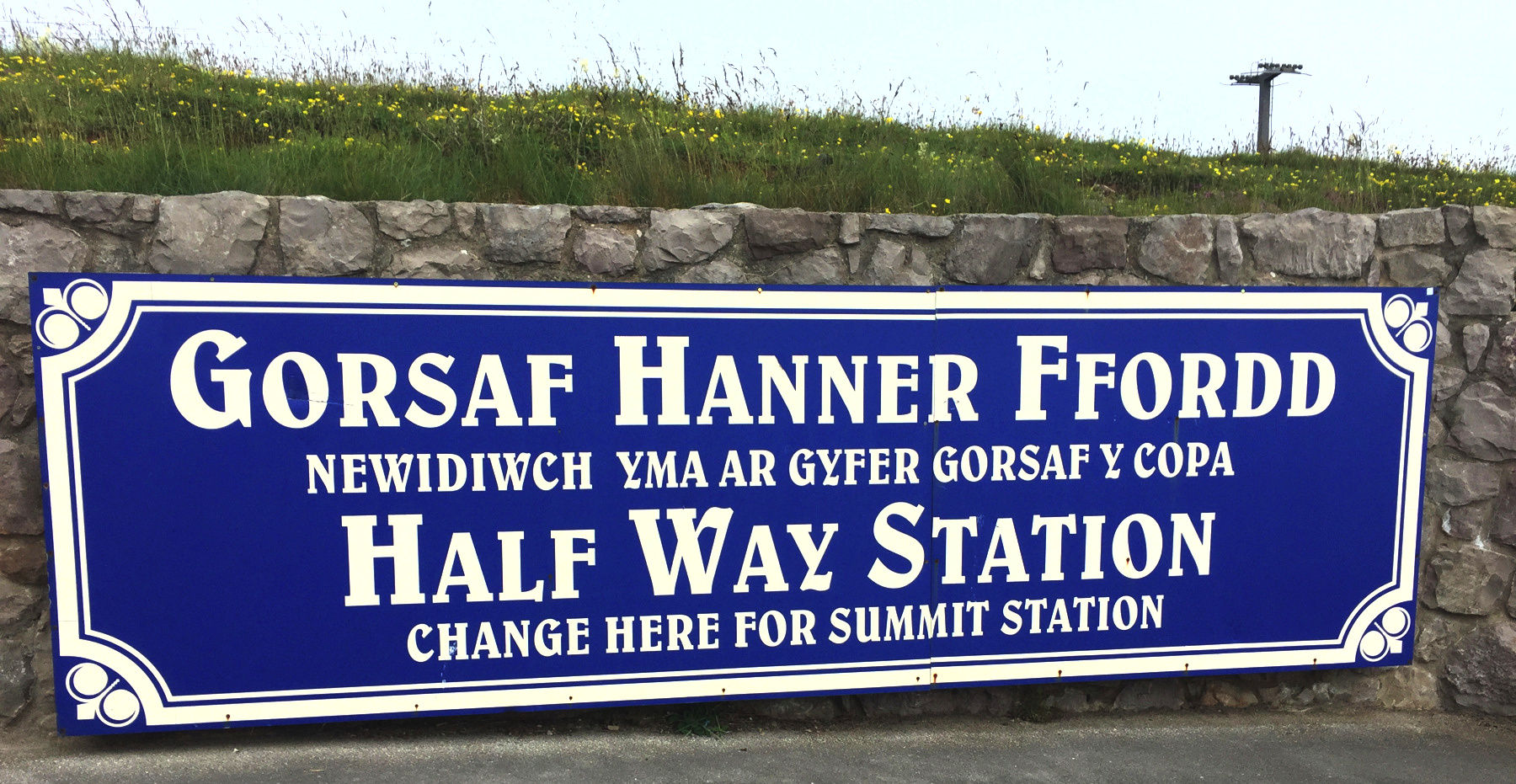
Gorsaf Hanner Ffordd. You might recall that the Old Station at Aberyswyth was yr hen orsaf but this is gorsaf. That was because former has a "soft mutation" following n but this is the base form with the g. The Welsh is literally "Station Half Way". No mystery. The next line is literally "Change here on for station the summit". If you recall the "stop look and listen" sign at Aberystwyth, you'll know that the wch suffix means it tells us what to do.
We are allowed views of the Half Way engine house, which provides power for both funiculars. The present building dates from 2001. I can't describe exactly what we see here but I love the huge drums with cables wrapped around them. In the last picture, the whited out thing is the housing around the electric motor for the Upper Section.
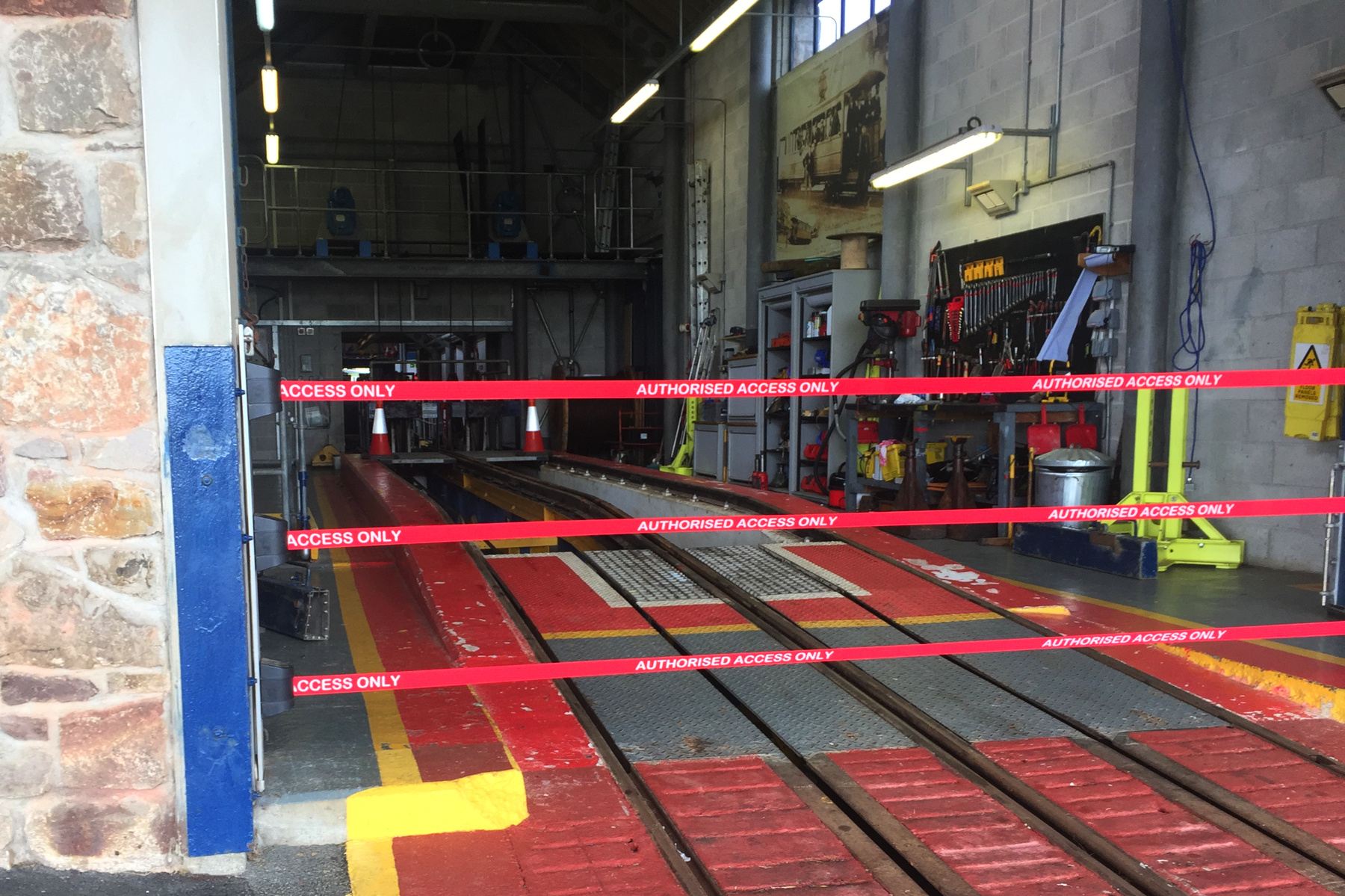
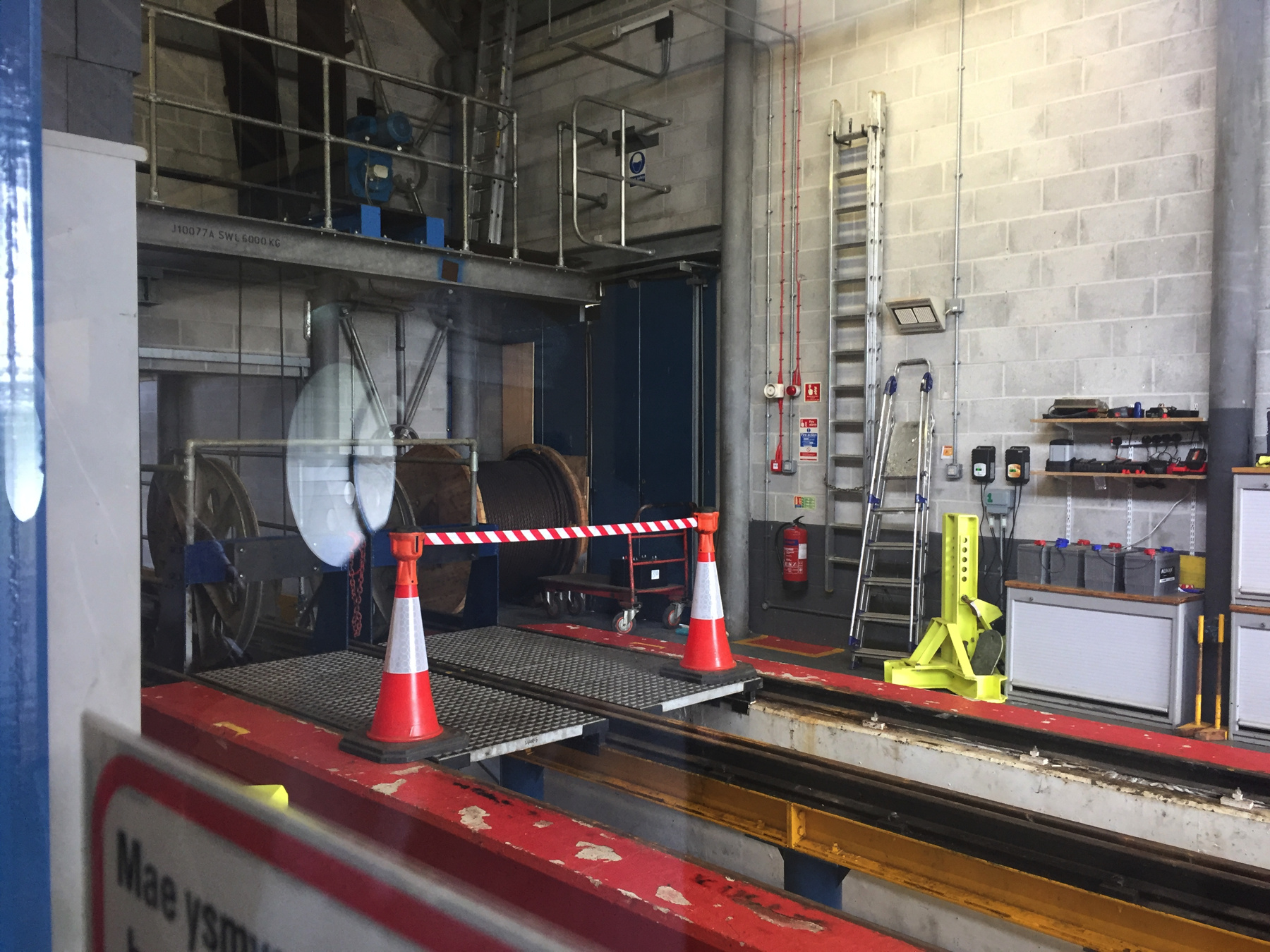
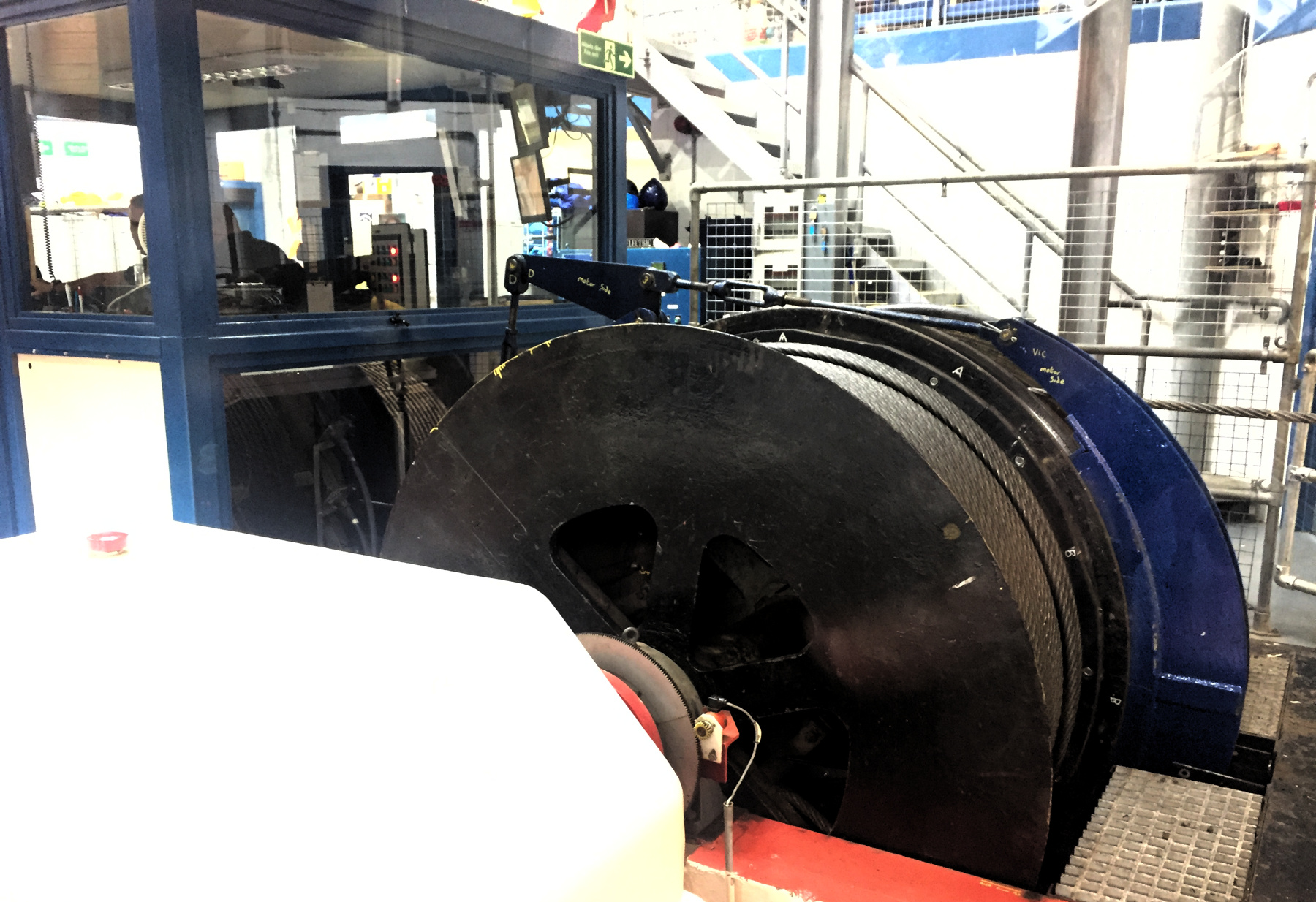
Let's continue on the Upper Section. Here is tram 7 at Mid Way, and two pictures from above that point. The level crossing with the road to the church of Saint Tudno[note 1] has two cuts for the two cables. Turning around from the same position, we see the track running up hill with plenty of support for the cables going around the curve.
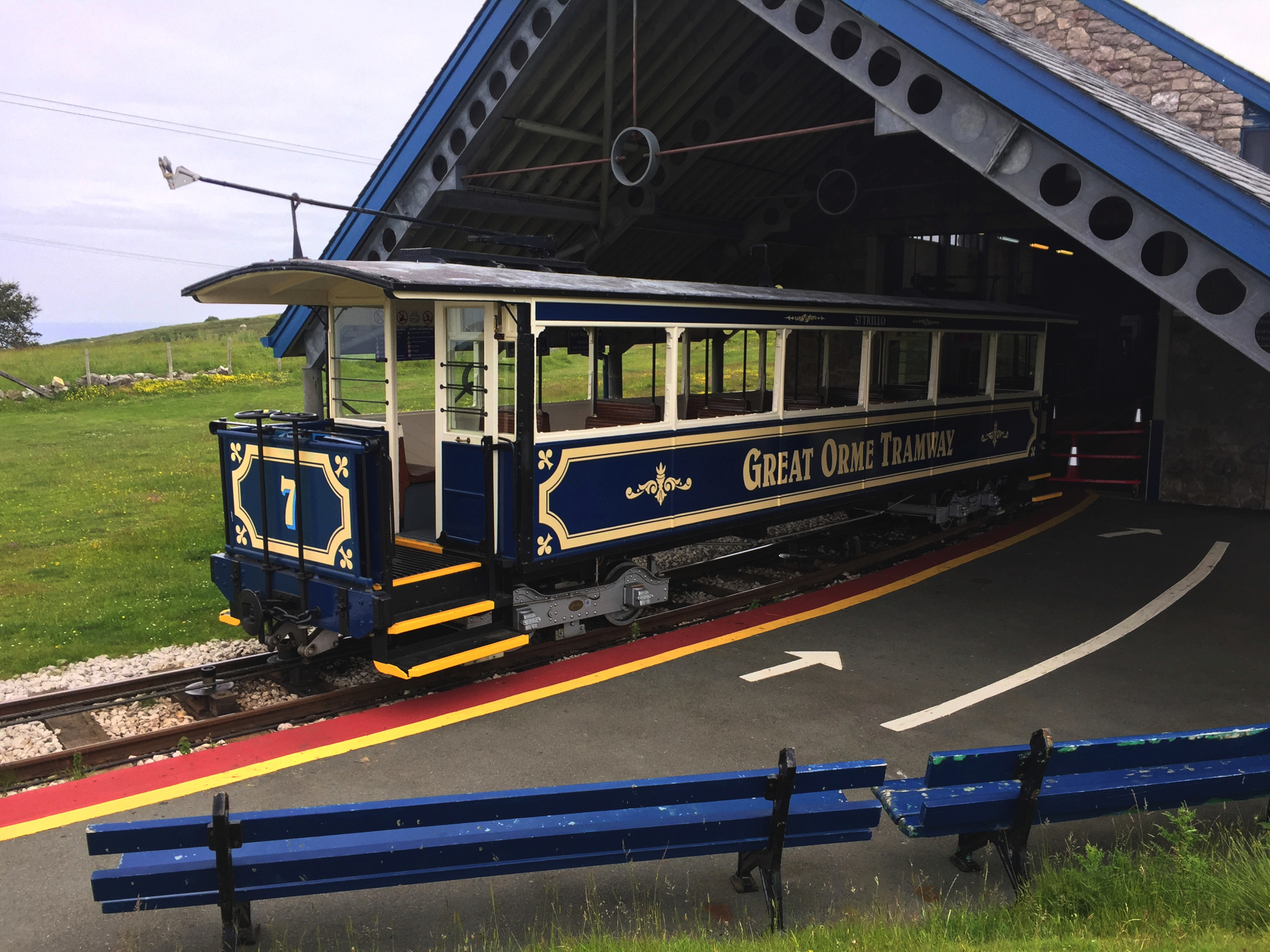
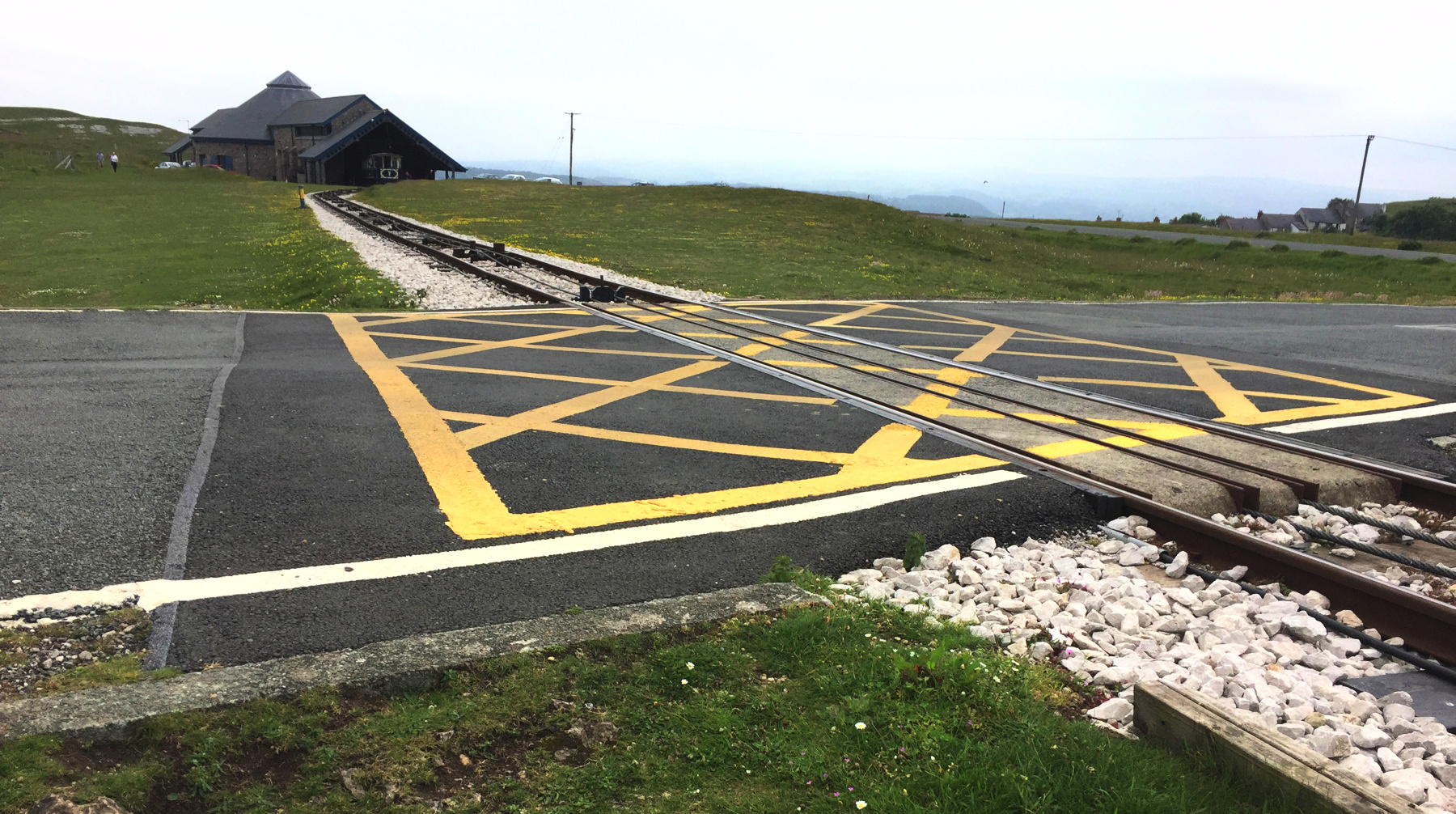
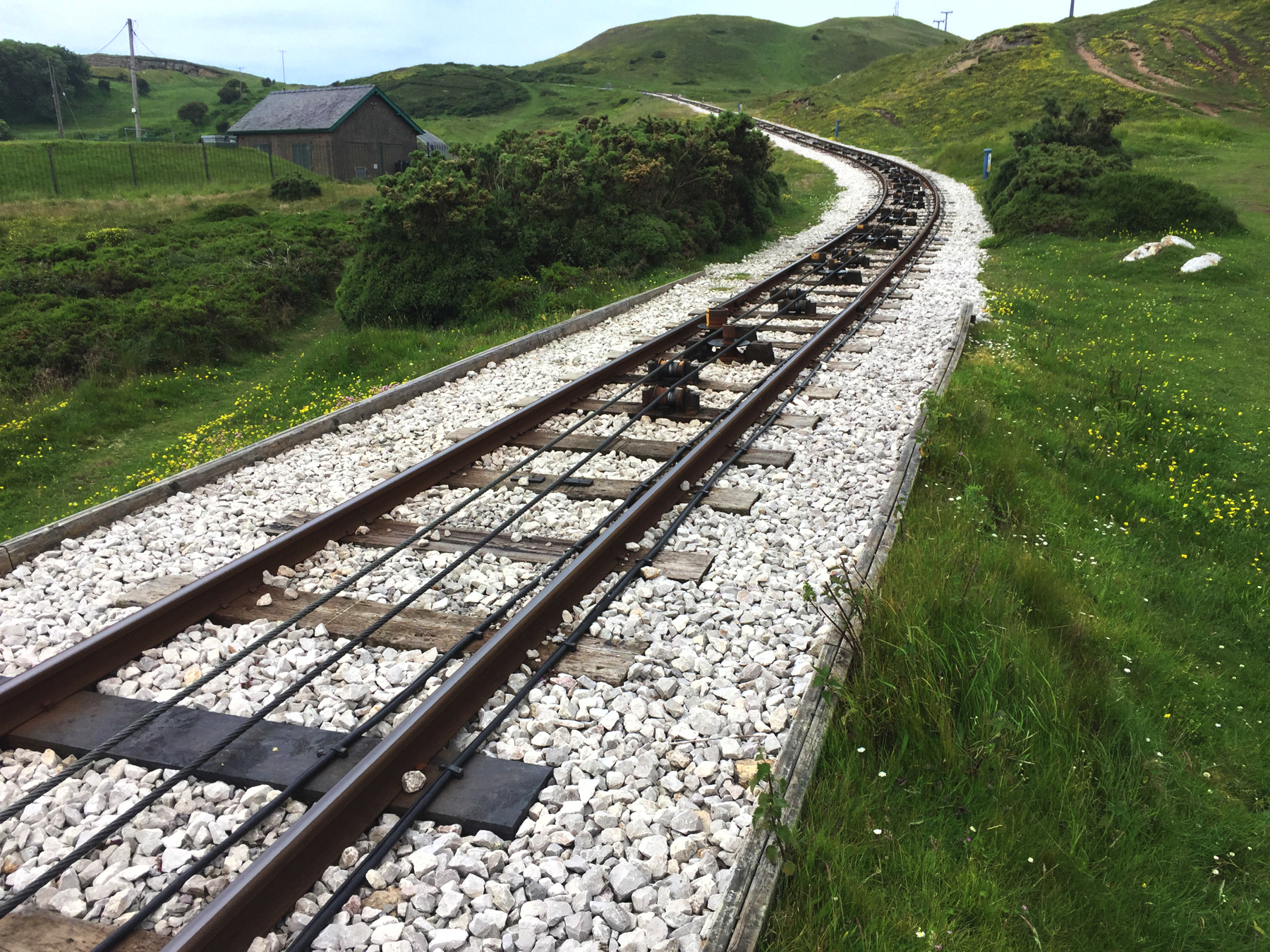
The "pass by" is just barely visible in the distance in the picture above, and it's out of sight below in the picture below, where tram 6 goes down from the cutting, as 7 comes up. Beyond 7 is the level crossing and Mid Way station.
I wish I had walked a little farther to examine the pass by. It is critical that each tram car goes the correct way into the double track. The web page says that the winchman at the engine house slows the cable for the traffic lights at the top of Old Road and also at the approach to the points (switch), to be ready for a possible signal to stop the cable. The "points levers" display the car number so that the attendant at the front of the car can check the position and send a stop signal to the winchman if needed.
But how are the switches set? On a level cable tramway between buildings at Minneapolis Airport, single track except at the passing place, I saw a simple mechanical method in which the cars push trailing points into position, setting them correctly for their return. After this web page went up my friend Clive referred me to an accident report from 2010 that describes the mechanism in great detail. Cars do push the trailing points are pushed into position, but it's much more advanced than that. In addition to observation by the attendant on the car, but the winchman also confirms the position both by en electrical signal and a cable television camera.
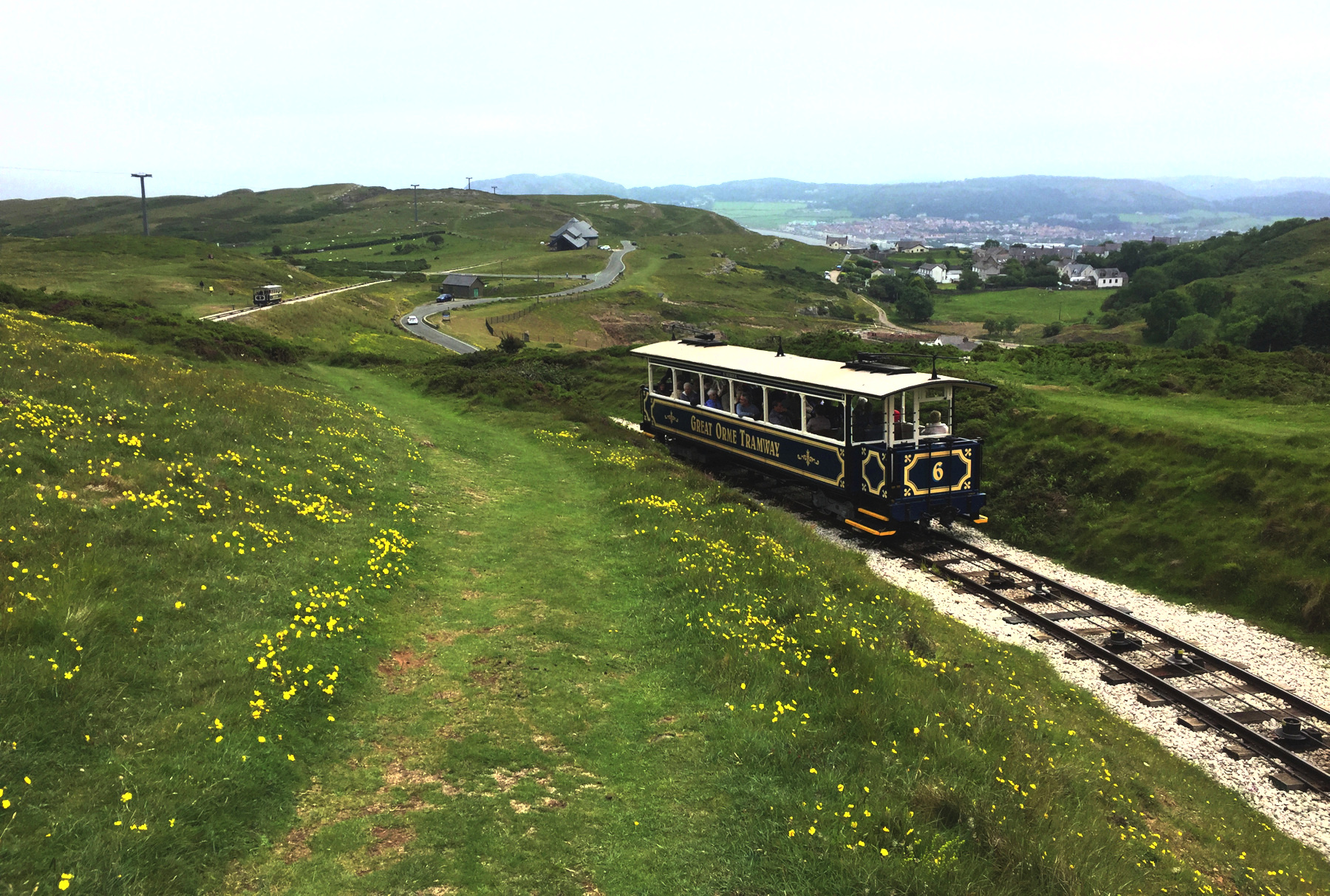
Below, the cutting, and a view up from the cutting as tram 6 comes down.
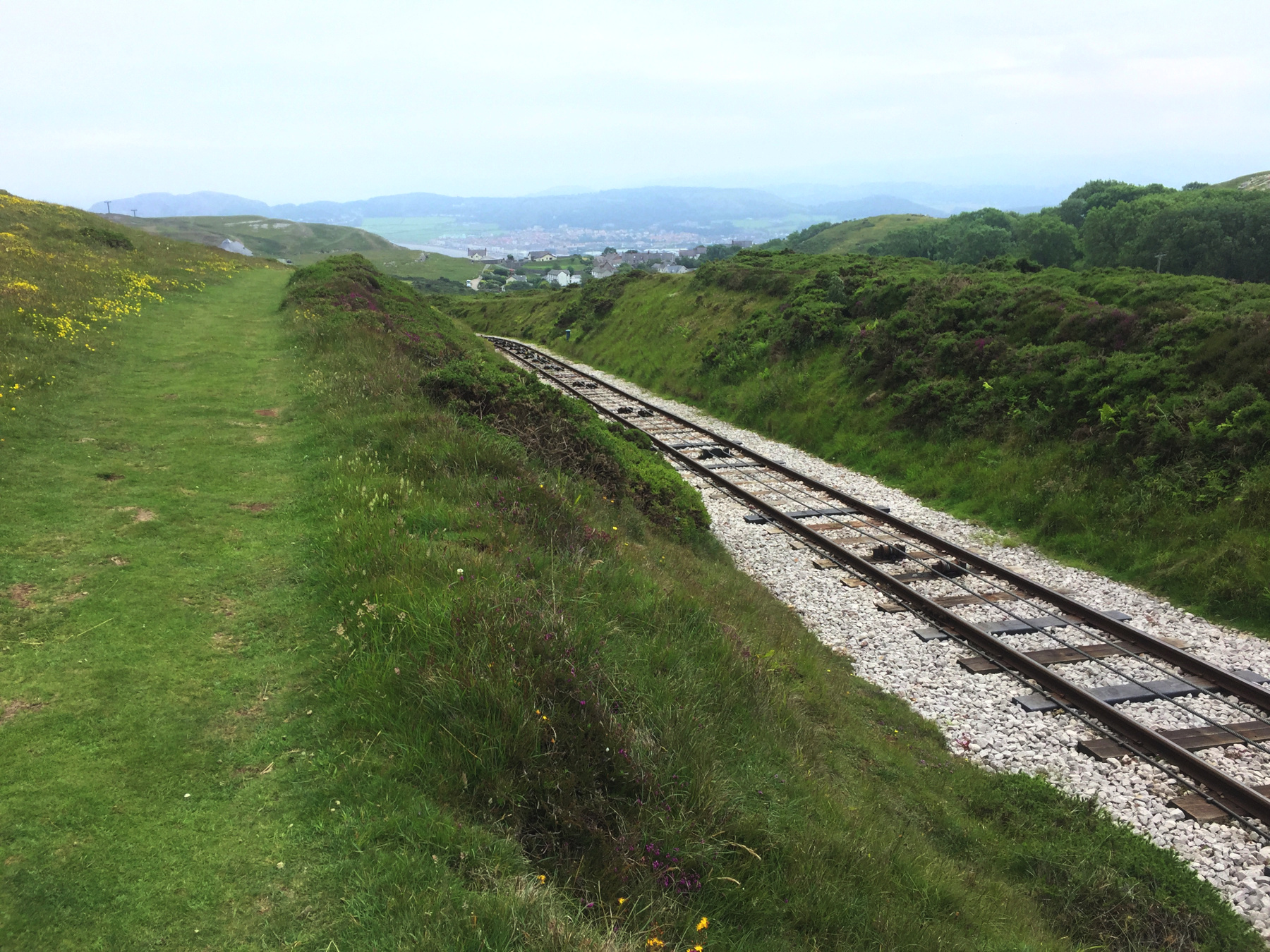
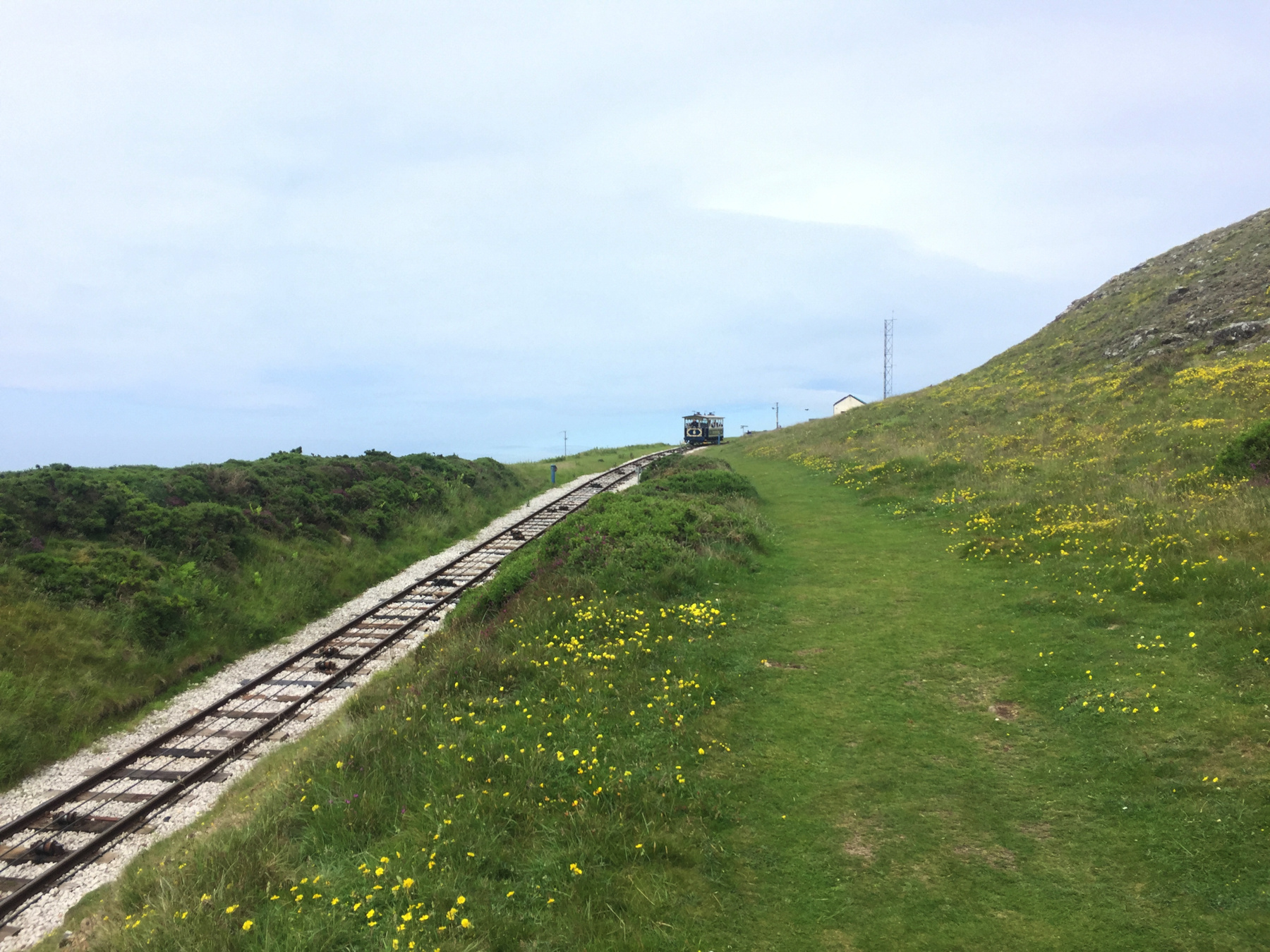
Two studies of the pulleys that control vertical and horizontal curvature.
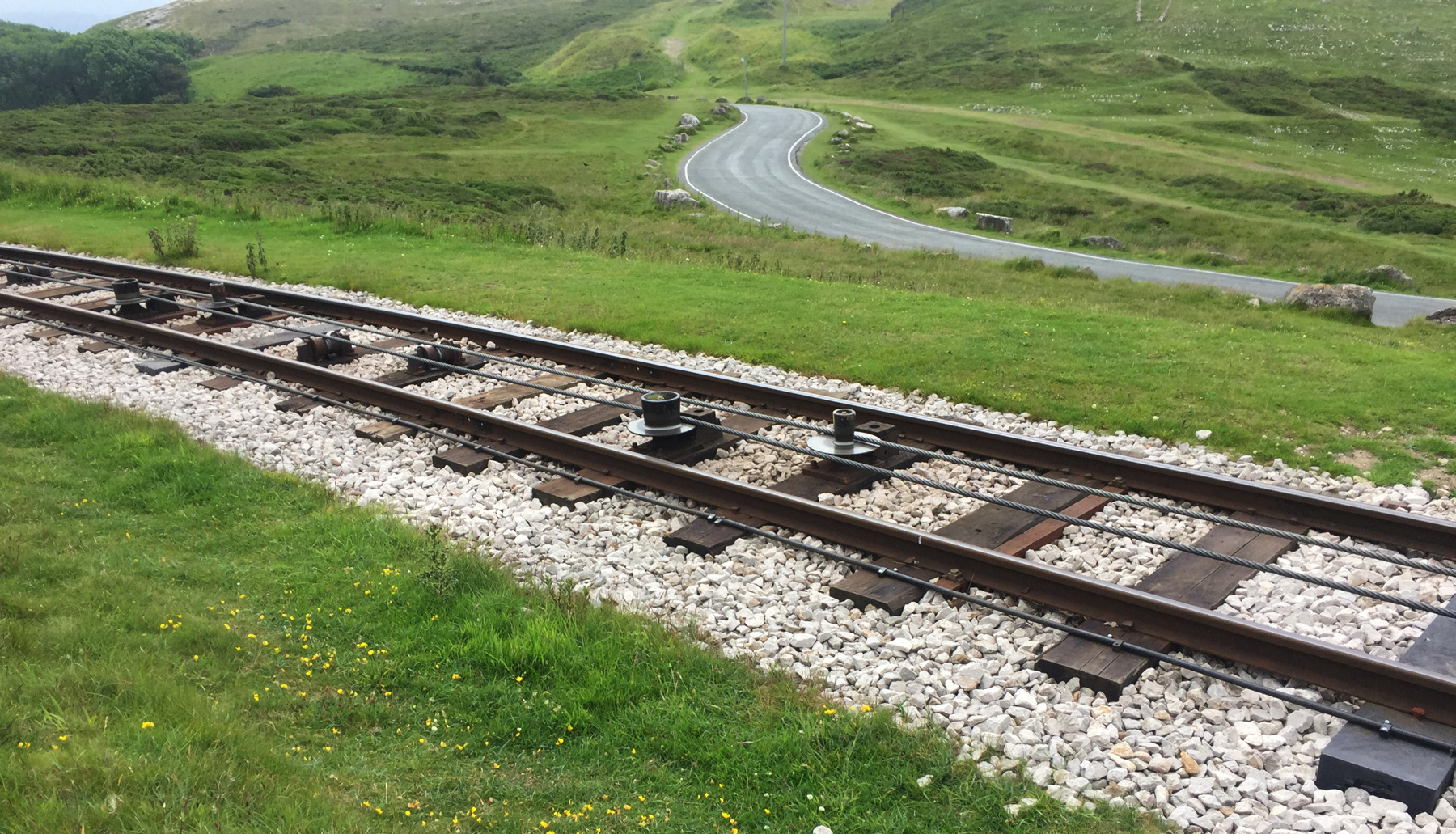
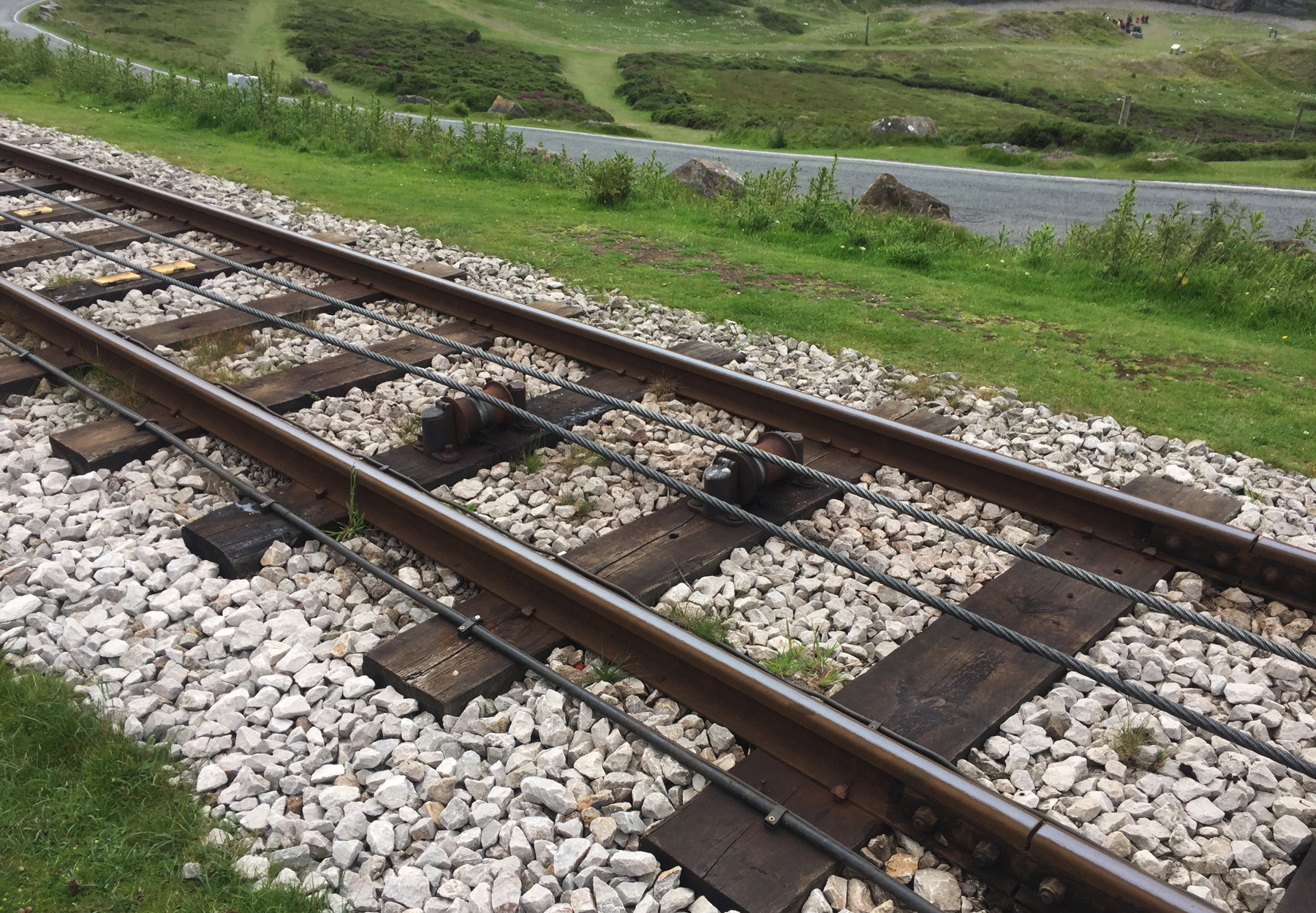
I walked up to Pen y Gogarth, the summit! All right, most of it was by done by riding the tramway. I can't fool you. But some of it was walking up to Victoria station and some more of it was by walking up from Summit station, which is just off to the right of this picture.
Beyond the playground and the tramway is the Bishop's Quarry and the Hill of Names, and beyond that across Conwy Sands is the hill Penmaen Bach. The Hill of Names, to the left of the quarry, is the result of people with time on their hands moving around loose quarry stones to spell names. I don't think it goes back to the Norsemen.
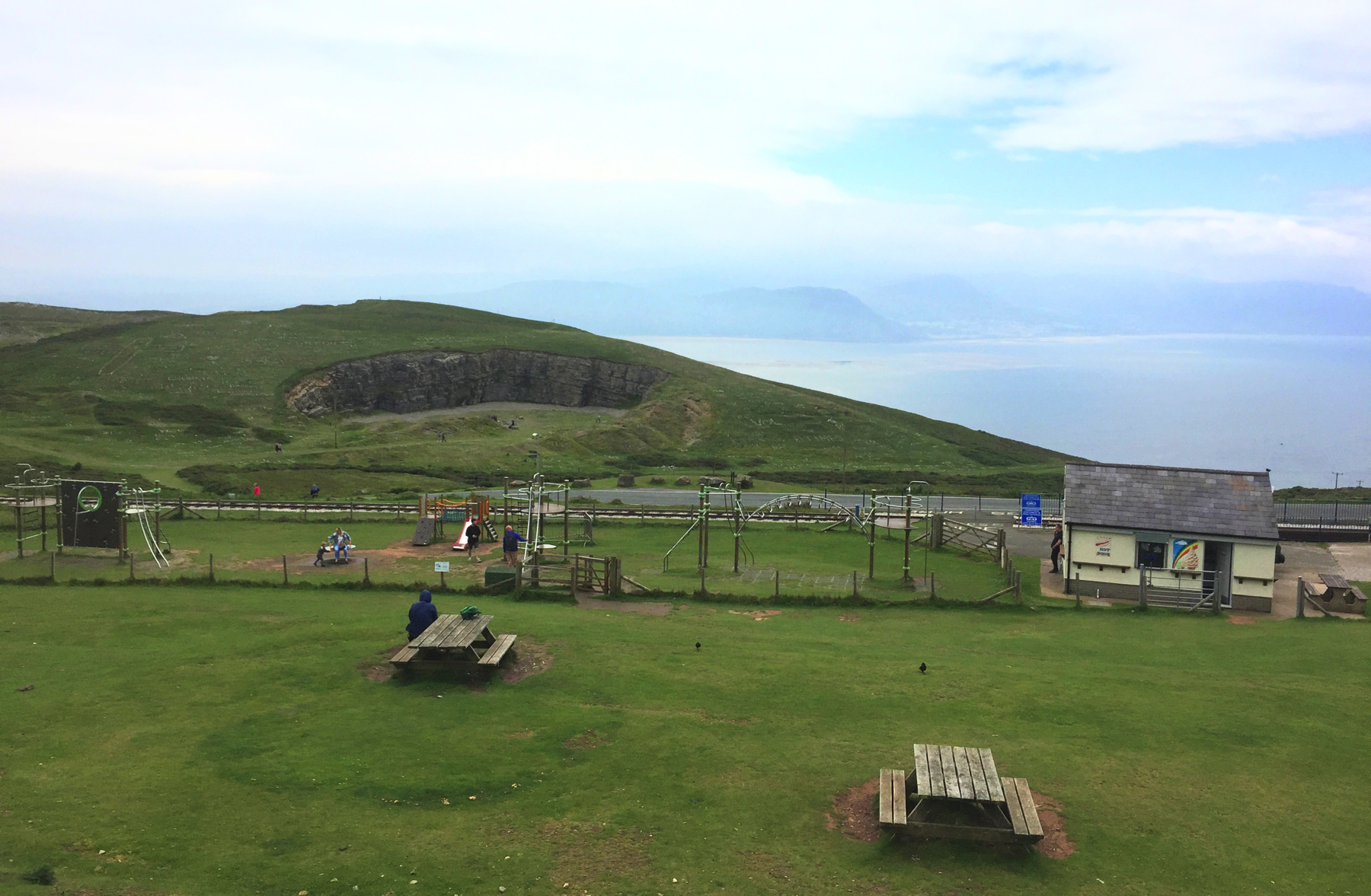
I forgot to take a picture of Summit station! It's not a master work of Victorian architecture, or Victorian at all, dating from 1992 and including a Great Orme Visitor Centre. In fact there was no shelter at all at the summit before 1965, but just a little stone shed for the pulley wheel. I had wanted to get a picture of both ends of each funicular. Oh well. I do have a view looking out of Summit station from tram 6, and a view of the footpath level crossing outside the station, and a nice portrait of tram 6.
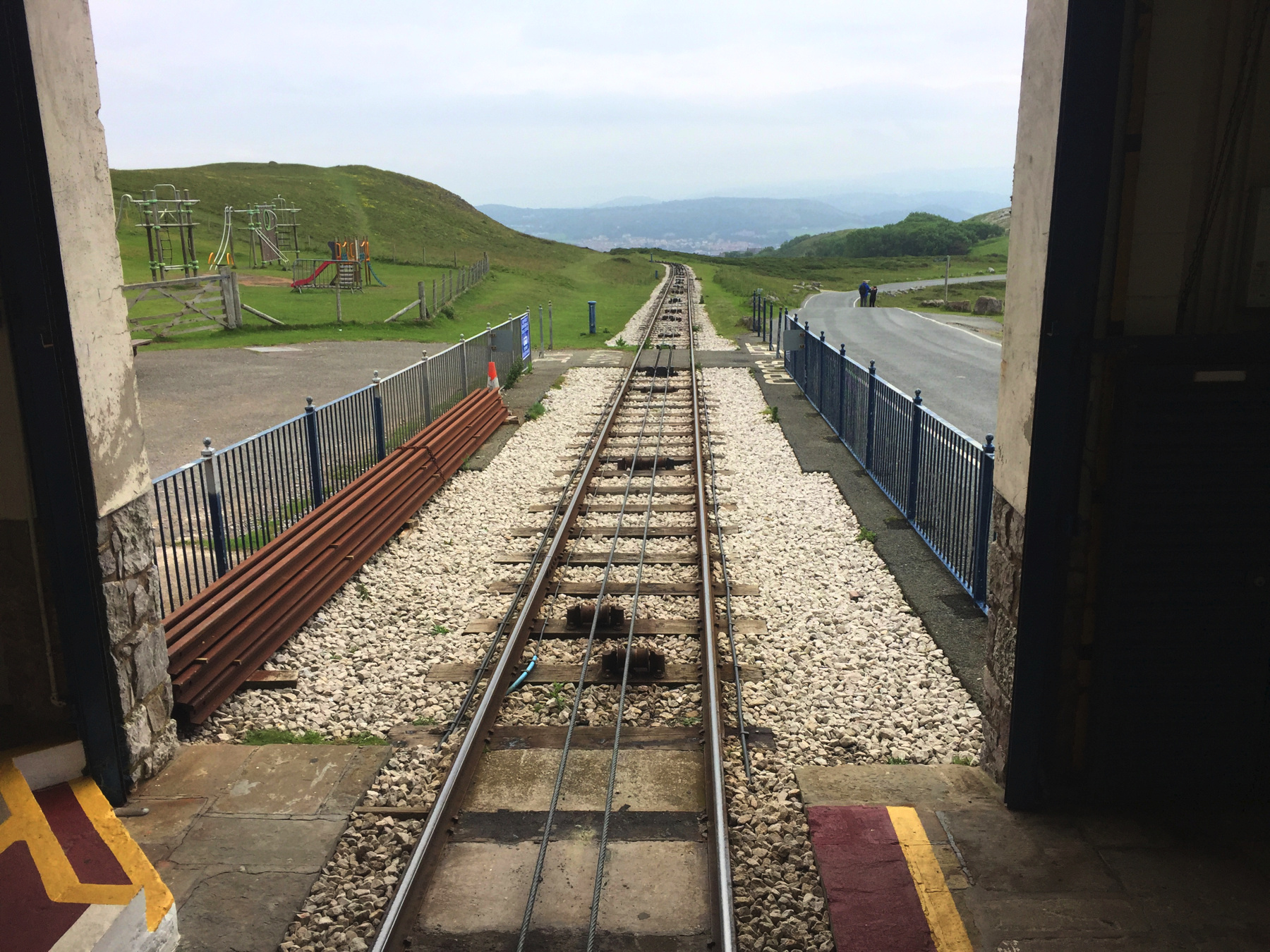
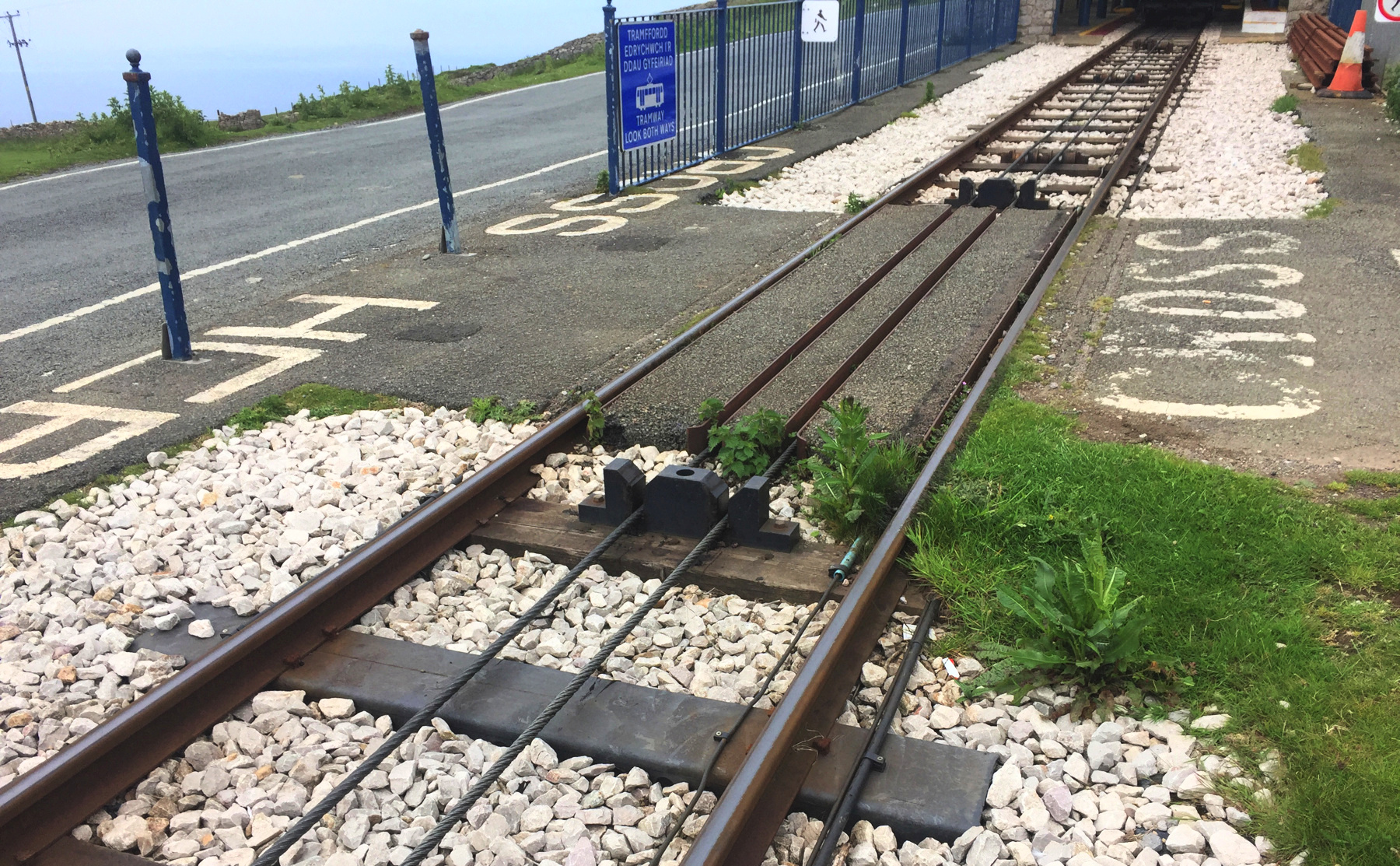
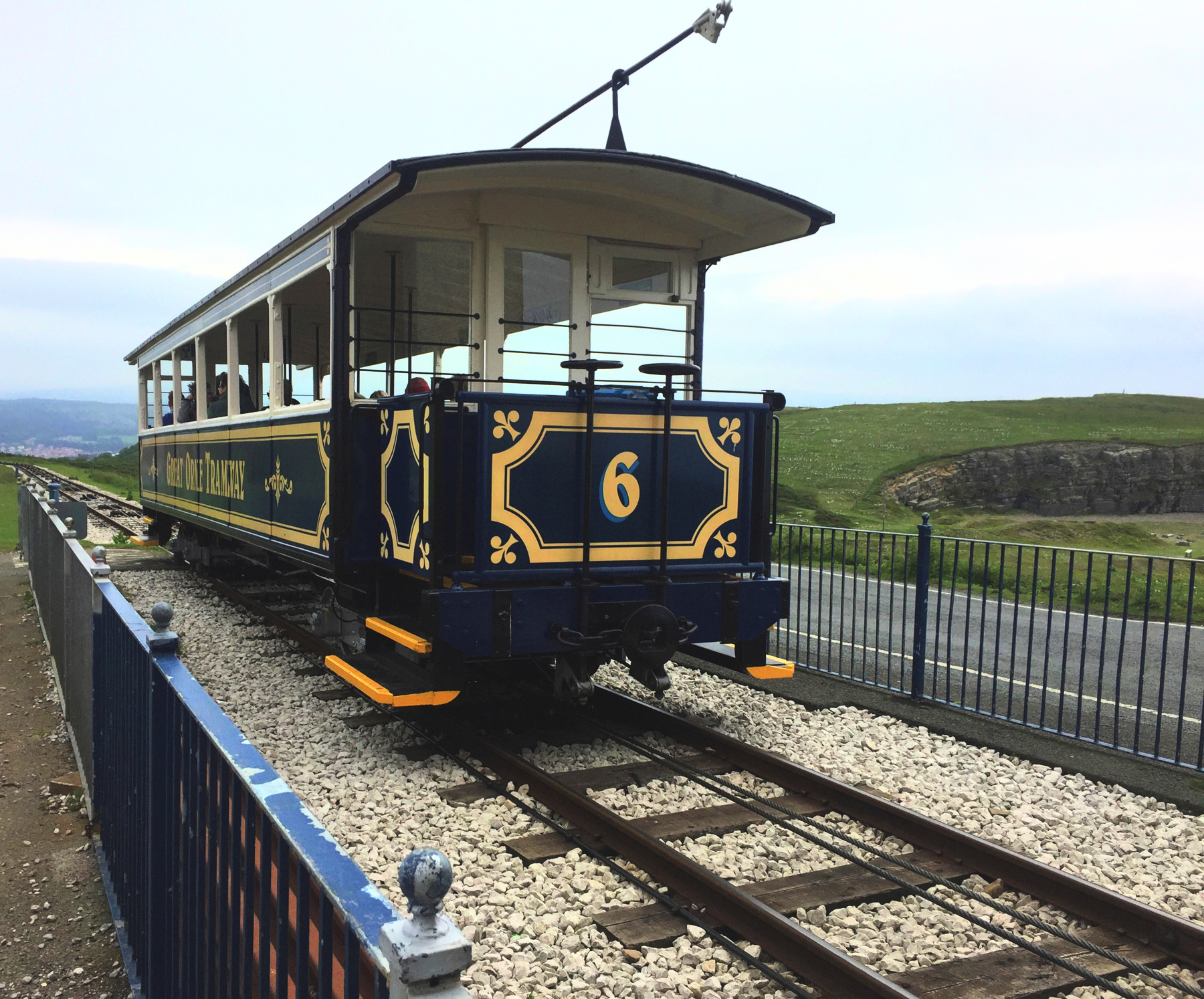
For the record, here's a Google Street View image of Summit Station.
Image capture: June 2018. © Google.
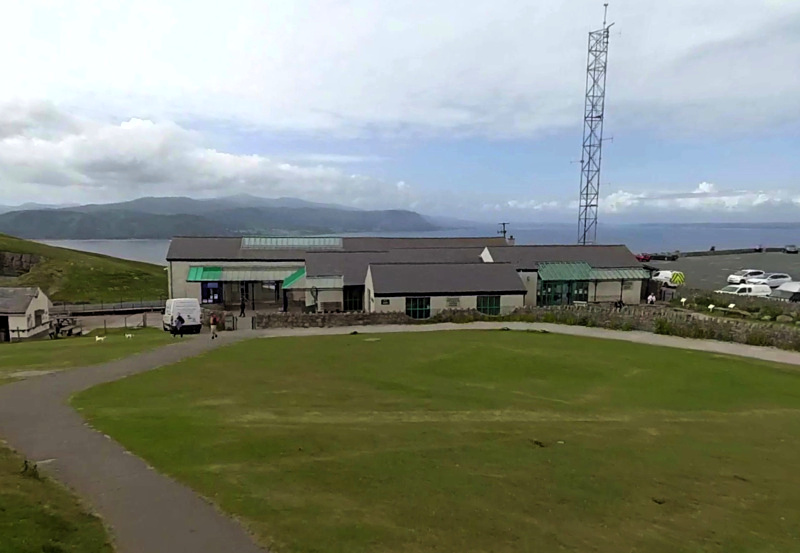
I had not had any food since London, so I went into the King's Head next to Victoria station. After that—if you're like me, you want a little more of that insane street running section—so I waited for a tram to be going up and got more.
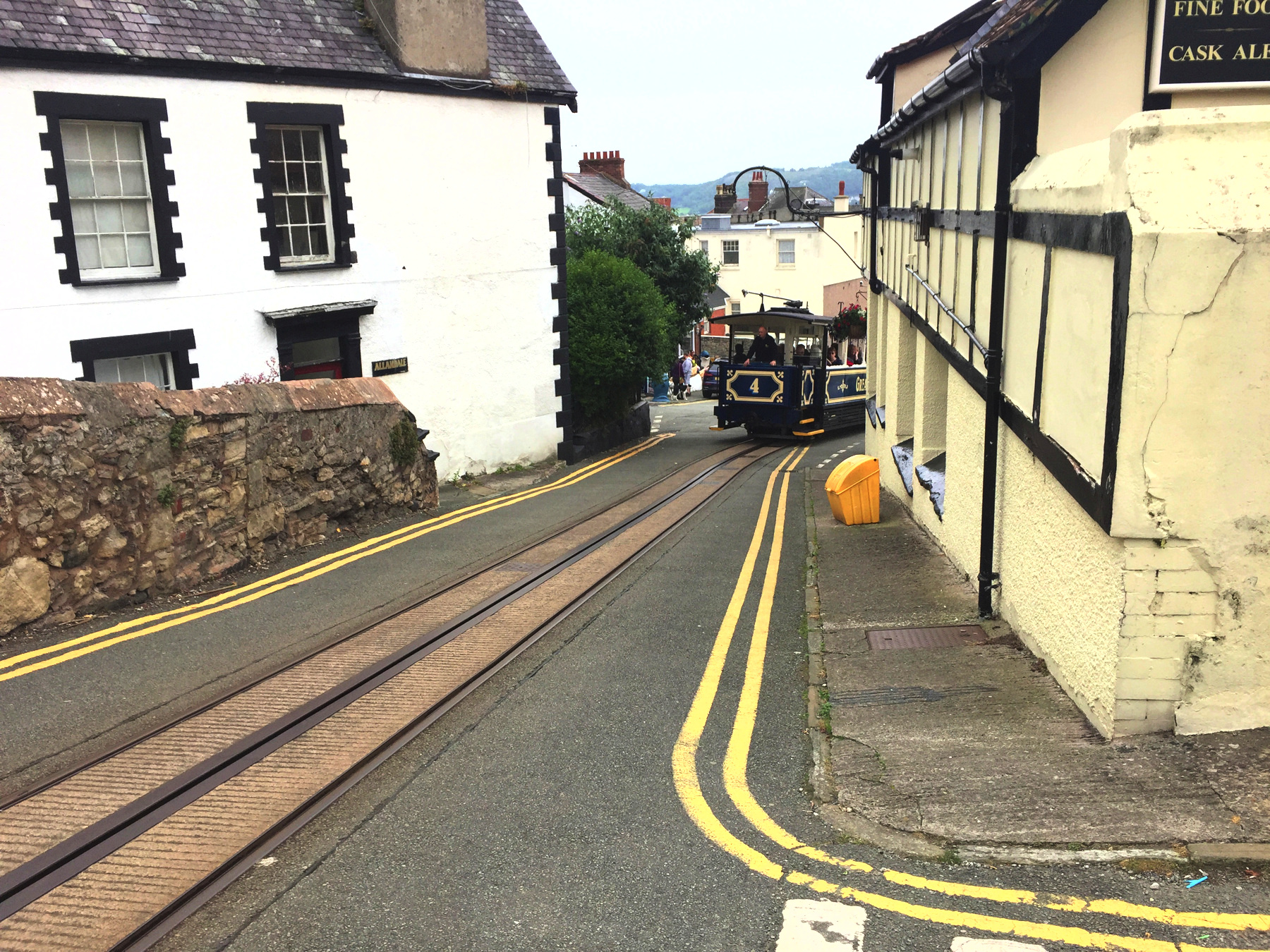
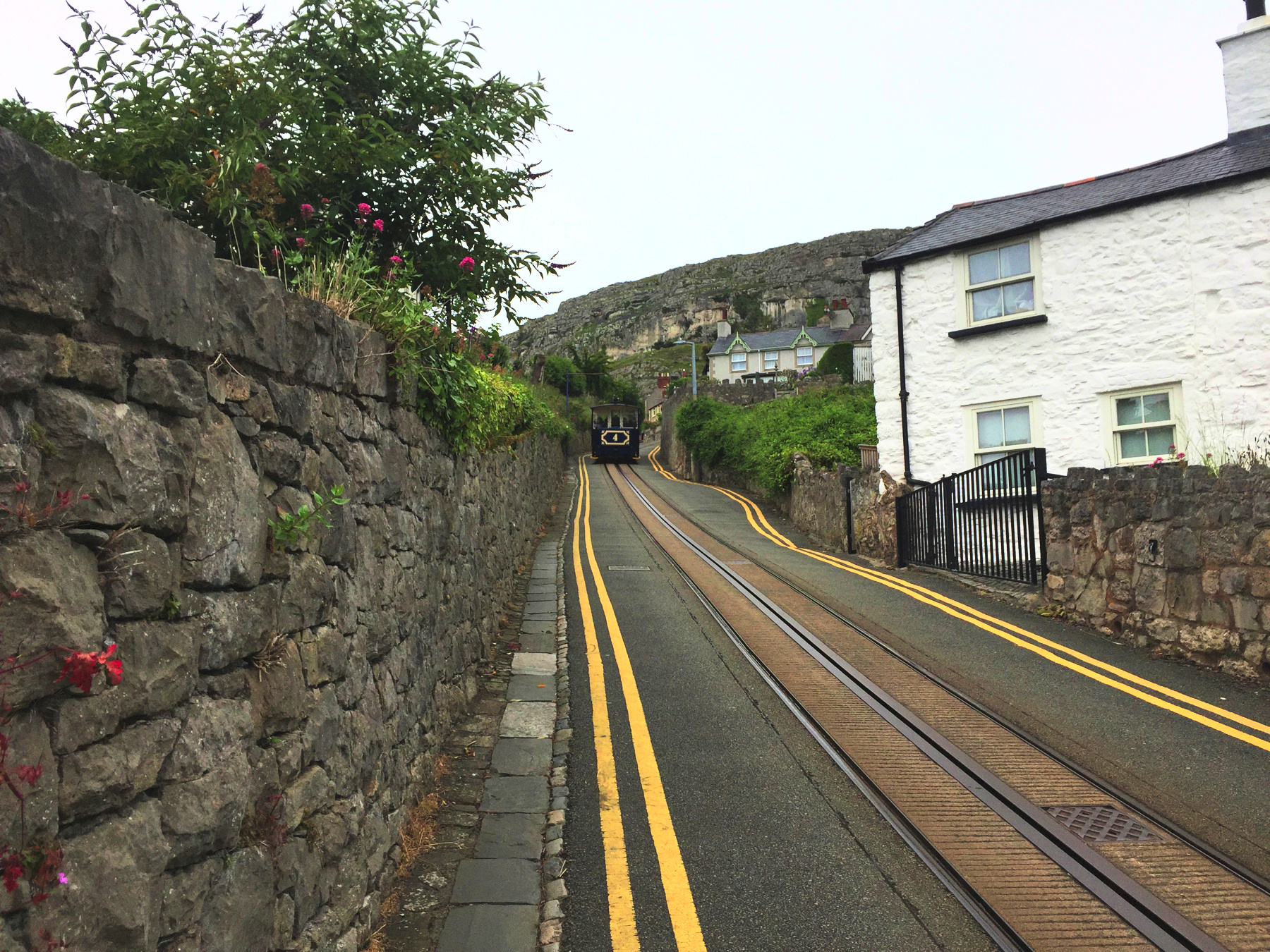
And so, goodbye to Llandudno. It seems the Welsh for platform is platfform. The monogram is that of the London, Midland & Scottish Railway, one of the four major companies after the Grouping of 1923.
I rode "backwards" on the train to Llandudno Junction, to get a last look at the Great Orme.
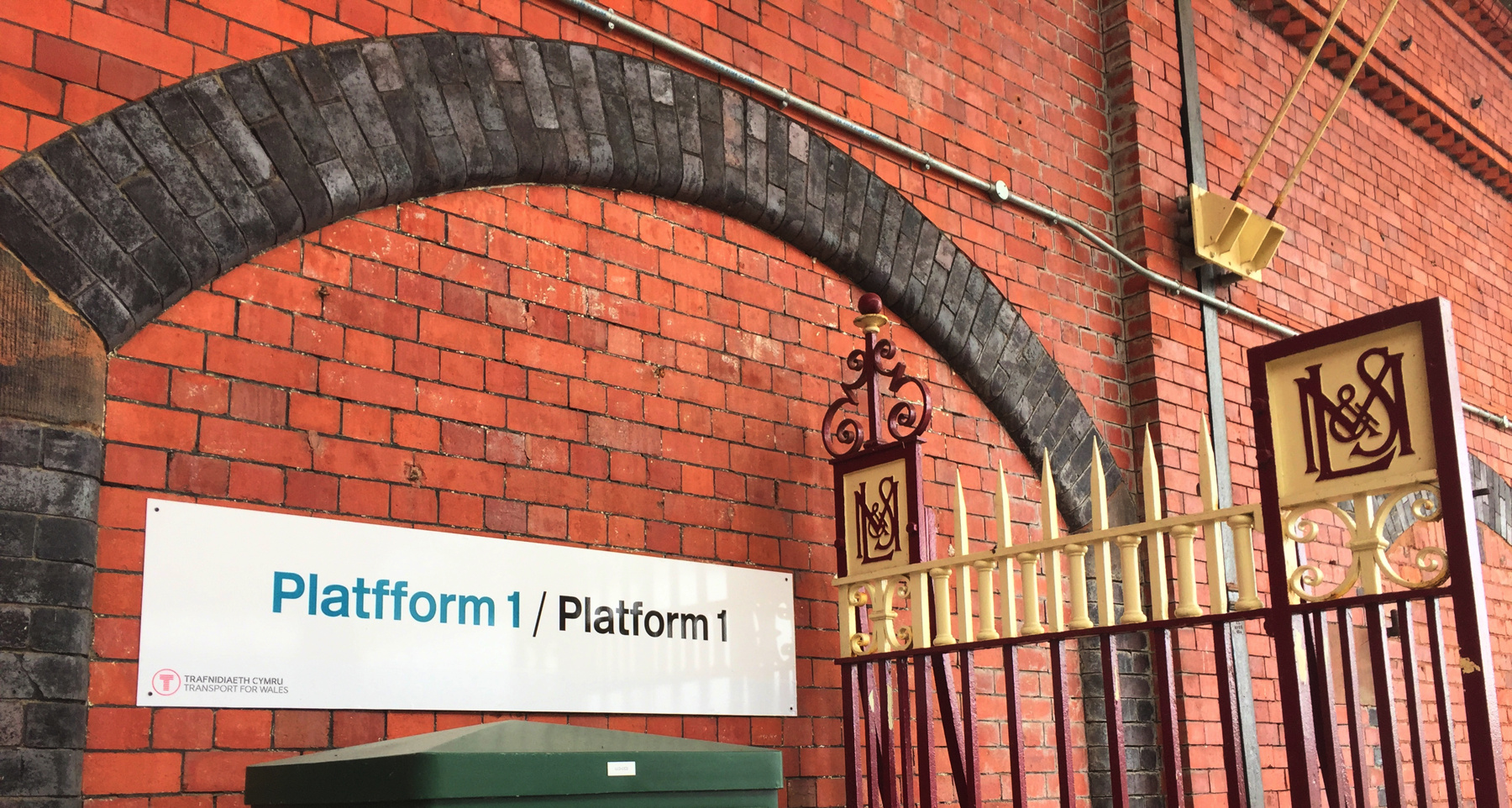
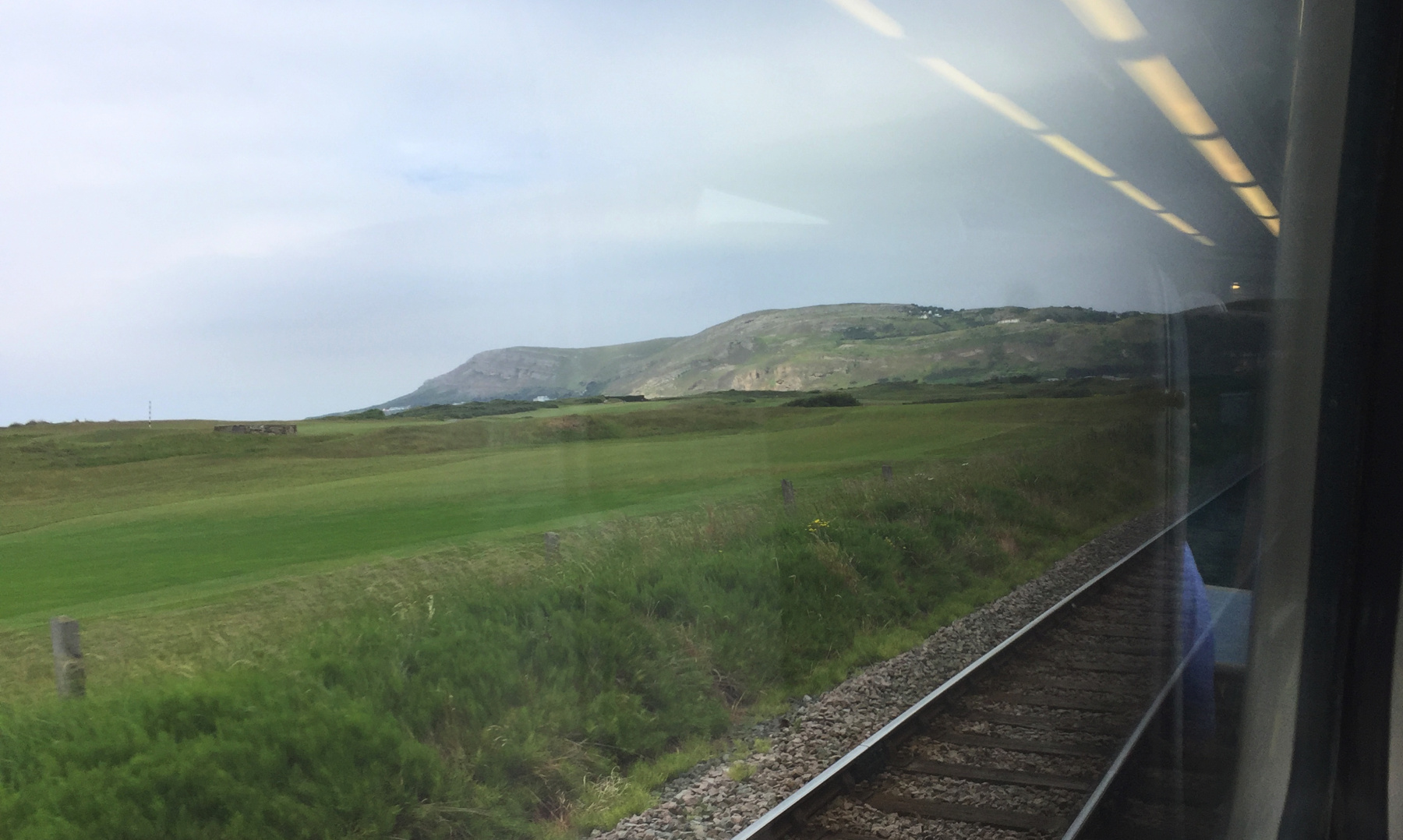
But wait! That's not all!
As the train runs along the shore of Conwy Bay, you can hardly miss the sight of Conwy Castle. Conwy station is just a few minutes' ride across the water from Llandudno Junction. The castle is right there. How could I not go get a closer look?
At the junction station I learned that of the trains that branch toward Holyhead, only a few call at Conwy. I would be waiting hours for the next one. But that was all right. I can walk just over the bridge. It's not so far.
Yes it is. It's a mile. The castle is so immense that it looks closer than it is. At about the point where turning back was no shorter than going on, I realized that turning back was no shorter than going on. On I went.
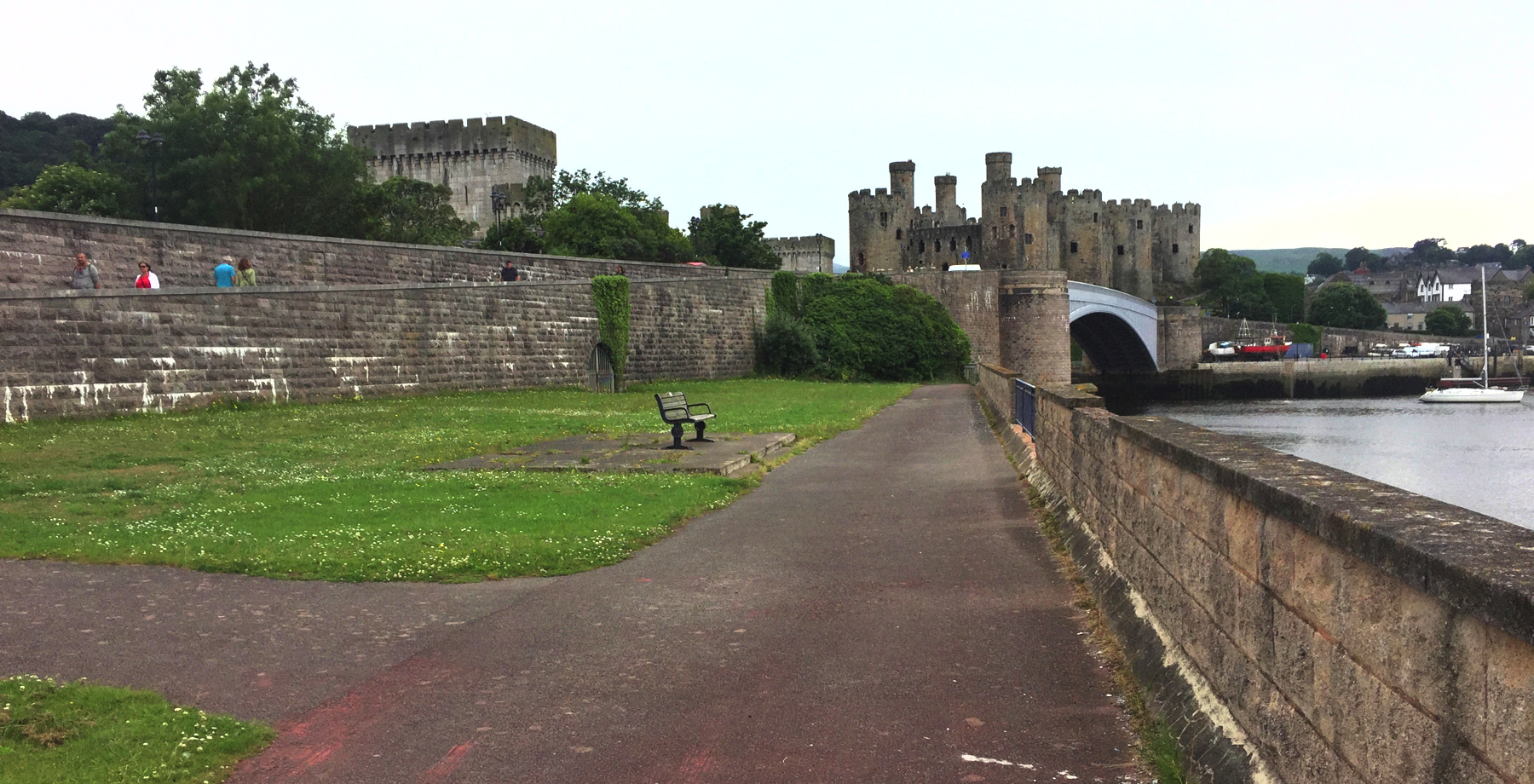
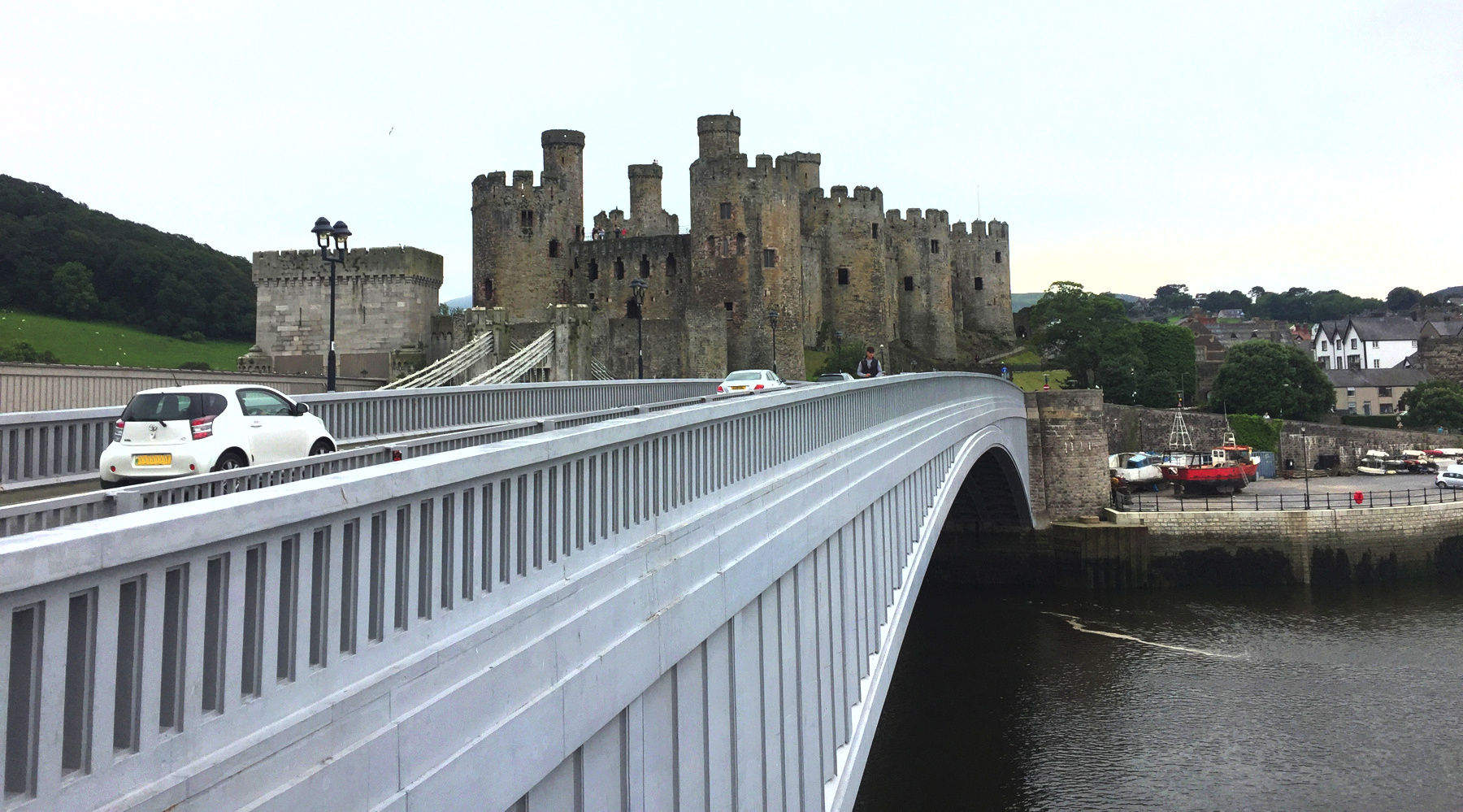
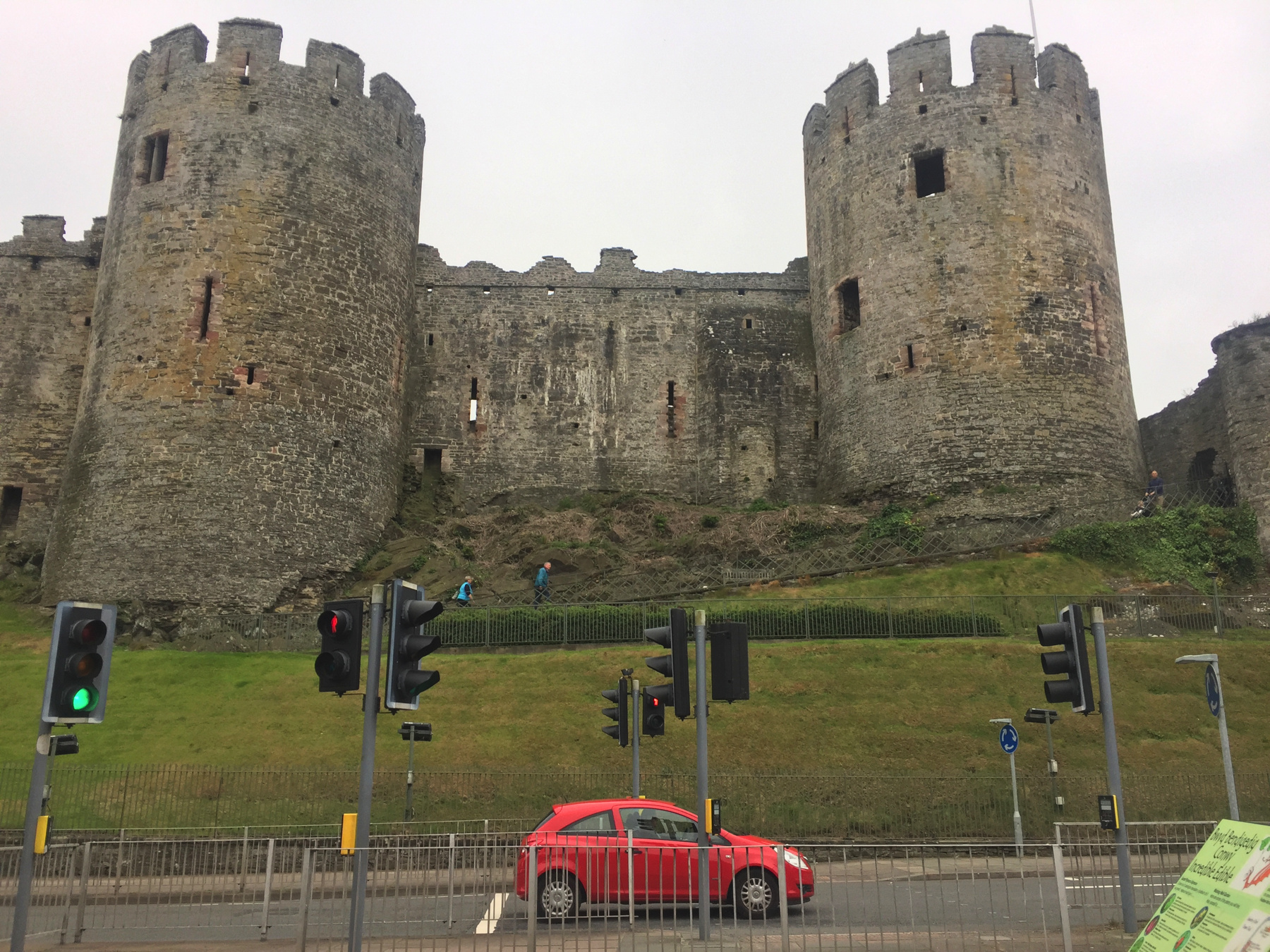
I gaped at the immense fortification, went under the arch in the city wall, gaped at the walls some more, and walked around to the back of the castle and gaped at that. I wondered how soldiers of the thirteenth century would feel if told to "take" the castle. I know how I would feel eight hundred years later. Maybe if I had dragons.
The railway was allowed to breach the city wall, and the company put up faux walls and arch to give the impression that it had always been there. Compare the cap stones of the nineteenth century with the thirteenth century work peeking through near the building on the right. When I checked the time of the next train back I found I had forty-five minutes to spare—pretty good—it could have been longer—so I looked again in the gift shop and took nothing, and walked around the back of the castle a little farther. And at length I did take a train.
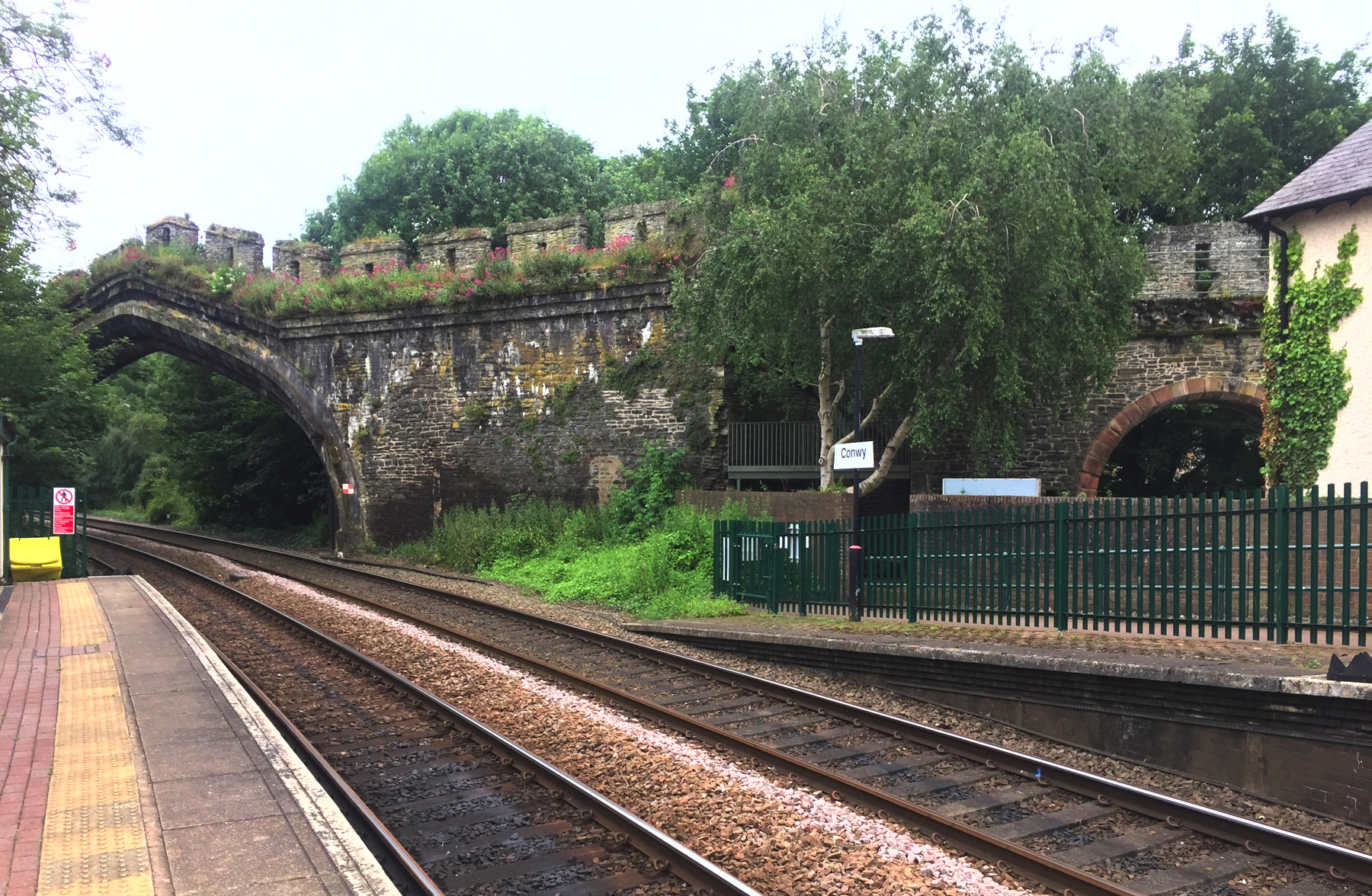
[note 1] Llandudno is named for Saint Tudno. The element llan refers to a piece of land and is often followed by a saint's name, "often mutated" says Wikipedia. The parish web site explains:
According to ancient Welsh manuscripts, Tudno was one of the sons of Seithenyn, who was himself son of Seithyn Seidi the King of Dyfed. Seithenyn was an important person in the kingdom of Cantref ofa Gwaelod, ruled by Gwyddno Garanhir (Gwyddno the long legged), and might have been a co-ruler. Cantref ofa Gwaelod was a legendary kingdom, below sea level, in the area which is now Cardigan Bay. This was a fertile land protected by a great dyke with sluice gates. Seithenyn was custodian and keeper of the gates but was blamed for allowing the land to flood and to be lost below the sea. It was after this that Tudno, and his brothers, entered the monastery.
Great stuff. It sounds like J.R.R. Tolkien wrote it. Tudno wanted to atone for his family's shame. (By the way Cardigan Bay is at Aberystwyth.) The administrators of Mostyn Estates, owner of the much of the Great Orme and other properties, put it this way:
The name of the church, parish, and town of Llandudno is derived from that of St.Tudno. Remarkably little is known of the saint's life and legacy though he has been commemorated on June 5th since medieval times. Presumably living during the 6th century, legend suggests that Tudno was one of the sons of king Seithenyn of Cardigan. Despite this lack of biographic and hagiographic information, St. Tudno did leave his mark on the landscape of Y Gogarth. Apart from the ancient parish church founded by St. Tudno on the northern slopes of the Great Orme, the headland also features St. Tudno's Well, a rocking stone called Cryd Tudno, and a cave named Ogof Llech which is said to have been St. Tudno's cell. Towards the end of the 17th century, Sir Thomas Mostyn of Gloddaith (c.1651-92) frequently utilised the cave as a fishing hideout.
From greatorme.org.uk I learn:
Saint Tudno's ancient church has been heavily restored many times until nothing remains from Tudno's day. The church, built and rebuilt over many centuries, achieved its final form in the 15th century. The roof blew off during a fierce gale in January 1839 and it was not restored. Rather the Church authorities decided to build a new church on the other side of the Orme.
—Saint Tudno's church was finally repaired fifteen years later, but—
medieval wall paintings were all lost in the restorations of 1855, 1888 & 1906. The church has a few ancient features. The font dates from the 12th century, and there are early sepulchral stones. Otherwise most of the furnishings date from the restorations. There is, however, a remarkable medieval survival, a carved wooden roof boss high above the chancel step depicting the 'stigmata' or five wounds of Christ.
I imagine Saint Swithun, Saint Tudno, and Saint Hubbins sitting around in the next world laughing, "no one knows what we did!"